Text
THE MAGIC RING
1924

On April 11, 1924, Mitzi came to Nixon's Apollo Theatre in Atlantic City with a tour of her latest Broadway triumph (her 7th), The Magic Ring by Zelda Sears and Harold Levey. The production was produced (like all of Mitzi's shows) by Henry W. Savage, with staging by Ira Hards and Dave Bennett.
The story of the three-act fantasy musical concerns a magical ring from the Kingdom of Kashmir 3,000 years ago. The ring finds its way into the basement of a modern-day NYC antiques shop and into the hands of a lowly organ-grinder Polly (Mitzi).
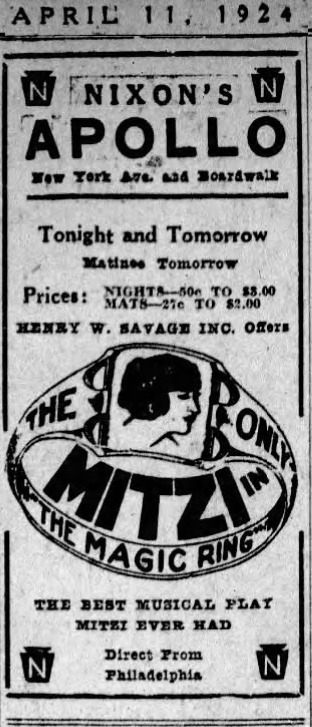
Nixon's Apollo Theatre, on the Boardwalk at New York Avenue, was a relatively new venue at the time. Two years later - in 1926 - Mitzi returned to the Atlantic City for out-of-town tryouts of her Broadway-bound musical Naughty Riquette.

The three-act musical comedy was on Broadway at the Liberty Theatre on 42nd Street and ran 96 performances. The cast (as on tour) included Jeanette MacDonald, who went on to a prolific film career.
#Mitzi#Mitzi Hajos#The Magic Ring#Jeanette MacDonald#Musical#1924#Nixon's Apollo Theatre#Atlantic City#Boardwalk
1 note
·
View note
Text
I’LL SAY SHE DOES
1920

I’ll Say She Does (formerly titled Dodo) is a musical by Avery Hopwood with music and lyrics by B.G. DeSylva. It was originally produced by A.H. Woods, George Marshall, and Avery Hopwood, with staging by Edward Royce. It featured Roland Young, Juliette Day, and Ernest Glendenning.
The story concerns Mrs. Warren, a young wife dubbed ‘Dodo’ by her husband. She is fond of keeping a string of male admirers at her command. Her husband Herb demands she devote herself to him alone. She half agrees, and employs her old friend Bobo Brown, recently returned from China, to invite her to his apartment for supper. Brown is told to report Mrs. Warren’s actions. Brown is engaged to Angie Martin, and wants to cancel the supper to spend time with her. But Dodo will not be deterred, and goes to his apartment anyway.
One of Dodo’s admirer’s is Dr. Elliott, who’s wife believes the good doctor is planning to rendezvous with her at Brown’s apartment. Brown suspects she is a blackmailer and a string of misunderstandings ensues.
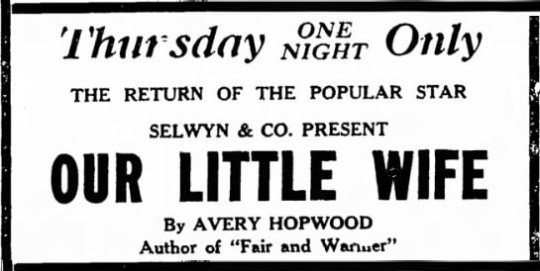
The book was based on Avery Hopwood’s 1916 play Our Little Wife, which played on Broadway at the Harris Theatre for 41 performances. It was filmed in 1918. The musical was initially titled Dodo.

The musical was inspired by the 1918 song “I’ll Say She Does” sung by Al Jolson in the musical Sinbad, DeSylva’s first Broadway outing. Also credited as authors were Gus Kahn and Jolson. Jolson recorded the song in 1919.
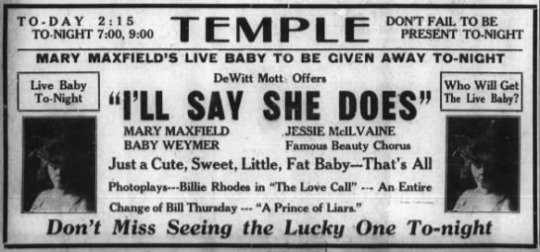
Coincidentally, in addition to the hit song, there was also an unrelated theatrical vaudeville titled I’ll Say She Does featuring Mary Maxfield. It played theatres in Indiana at the same time as the musical which was then still titled Dodo. One can only guess what was meant by giving away a live baby!
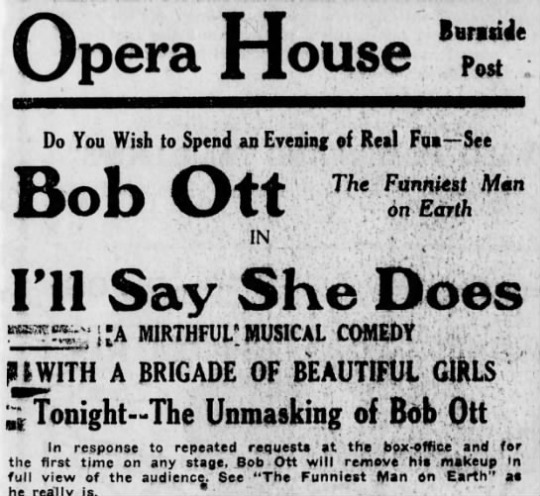
Closer to home, there was yet another theatrical attraction titled “I’ll Say She Does.” This one starring ‘the funniest man alive’ Bobby Ott. It was promised that he would remove his make-up in full view of the audience. The Saturday night performance would be followed by a fashion show and the lucky ladies in the audience would receive ‘cutie dolls’ from Ott. This ‘musical comedy’ (again unrelated to Hopwood’s) was playing in Mount Carmel PA on April 29 & 30, 1920.

The production premiered under the title Dodo on April 25, 1920 at Poli’s in Washington, DC. From there it went on to Wilmington's Playhouse, where its name was officially changed to I’ll Say She Does. May 5, 1920, it did one night at Rajah Theatre in West Reading PA.

The musical played the Globe Theatre (formerly the Cort) on the Boardwalk in Atlantic City on May 6, 1920. It featured the ‘smartest girls in the world’. The Atlantic City Press reviewed it as “Very Snappy.”
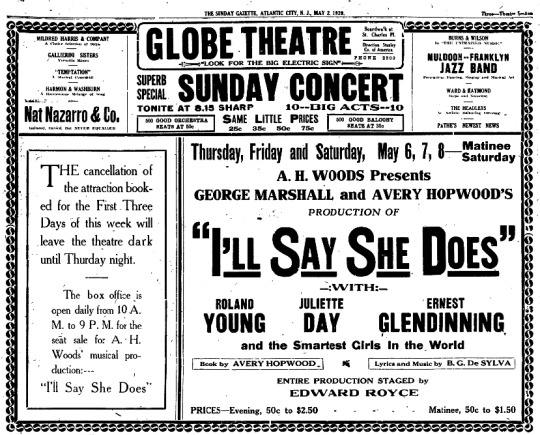
Unusually for Atlantic City, the split week engagement was extended, adding three more performances at the Globe.

The musical closed May 22, 1920 in Boston at the Shubert Theatre. Apparently being smart was not working, so the chorus removed their corsets.
“As a musical comedy it is sadly wanting. ‘I’ll Say She Does’ simply fails to ‘get across’. Mr. B.G. DeSylva’s ... lyrics are awful.” ~ FLETCHER SMITH, THE HARVARD MAGAZINE
On May 22, 1920, the musical closed shop for good in Boston, without ever gracing the Broadway stage. The title, however, lived on.

#I'll Say She Does#Avery Hopwood#Atlantic City#musical#musical comedy#theatre#stage#vaudeville#B.G. DeSylva#A.H. Woods#Dodo#Our Little Wife#broadway#Al Jolson#Sinbad#Edward Royce#Juliette Day#Ernest Glendenning#Roland Young#1920s
1 note
·
View note
Text
THE HAM TREE
1906 - 1907 / 1915
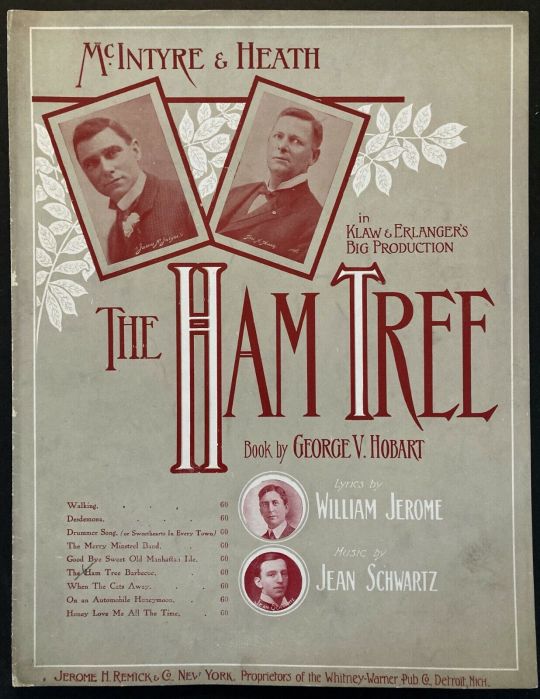
The Ham Tree is a musical in three acts by Jean Schwartz with Lyrics by William Jerome, and book by George V. Hobart. It was originally produced by Klaw & Erlanger and staged by Herbert Gresham, musical staging by William Jerome, starring McIntyre & Heath and featuring W.C. Fields.
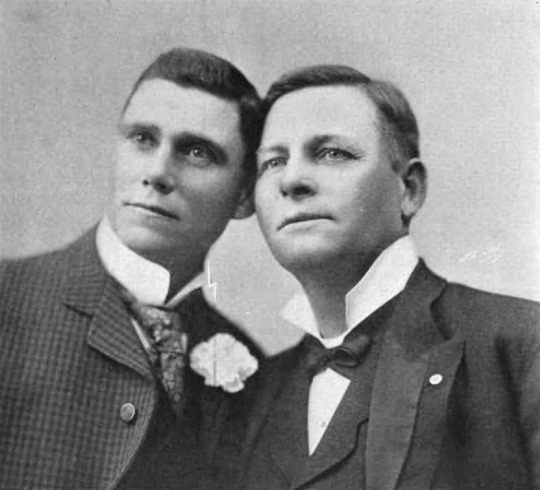
James McIntyre (1857-1937) and Thomas Kurton Heath (1853-1838) were white minstrel performers, vaudevillians, and actors. In 1874, they created a blackface tramp comedy duo act that became world famous. McIntyre played Alexander Hambletonian, a buffoonish stable boy, and Heath played Henry Jones, an entertainer who frequently outwits Alexander.

William Claude Duckenfield aka W.C. Fields (1880-1946) was a clown, juggler, and frequent Atlantic City performer, making his Broadway debut in The Ham Tree as Sherlock Baffles, a role written for him to incorporate his juggling skills. He went on to great success in films.
The play is based on a McIntyre & Heath skit also called The Ham Tree, which involved the two characters discussing how ham grows on trees 300 feet tall.
The musical takes place in North Carolina, Delaware, and New York City. In it, Hambeltonian and Jones are stranded in a small town and pass themselves off as a rajah and his minister to get free room and board.
In the months leading up to the Broadway production, McIntyre & Heath had begun incorporating a condensed version of the The Ham Tree into performances of other material as sort of a preview. They advertised their farewell to vaudeville. The musical began rehearsals on July 3, 1905 at the New Amsterdam Theatre in NYC.
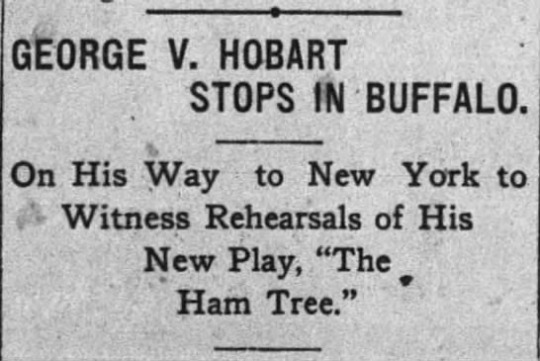
"I think Buffalo will like it. I know they will like Mclntyre and Heath, and Klaw & Erlanger are to put on the production in a manner that will be found marvelously beautiful." ~ GEORGE V. HOBART

The Ham Tree premiered in Rochester NY, at the Lyceum - “the only first class theatre in the city!” From there, it was replanted in Buffalo NY on August 21, 1905.

The Ham Tree opened on Broadway at the New York Theatre (1514-16 Broadway at 44th Street) on August 28, 1905.
About the Venue: The New York Theatre opened as the Olympia Musical Hall, part of a three-theatre complex, in 1895. It was renamed the New York in 1899, and, except for a brief stint at the Moulin Rouge, remained so until 1915, when it became a movie theatre.
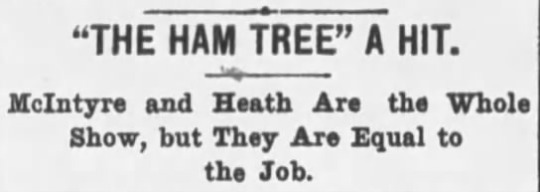
“Of course, there is no plot to 'The Ham Tree’. How could there be with that name? But no one misses it. The chorus has some new stunts such as gathering on the footlights and calling the bald heads to them with open arms. The ‘heads’ were perfectly willing to come, and even carry the suitcases which figure in one of the scenes.” ~ NEW YORK TRIBUNE
“’The Ham Tree’ is strong variety meat. It Is flavored with the burnt cork comedy that gained its performers popularity when Long Acre Square was little more than a wilderness and it is served with a vealy chorus dressing supposed to appeal to up-to-date appetites.” ~ NY EVENING WORLD
“The applause in its behalf was more noisy than convincing. McIntyre and Heath repeated three times their act, with slight and inconsequential variations. Each scene ended with a chorus, one of which is entitled to commendation. Among the members of the troupe is W.C. Fields of whose juggling too little was seen.” ~ CHICAGO TRIBUNE
The musical closed on Broadway on November 11, 1905 after 90 performances and went on the road.

On July 23, 1906, it arrived in Atlantic City NJ and played the Savoy Theatre on the Boardwalk. McIntyre, Heath, and Fields were still with the company. After this stint at the shore, the play returned to Broadway and the New York Theatre for the month of August 1906. The return engagement lasted 40 performances, shuttering on September 1st. But that was not the last of The Ham Tree.
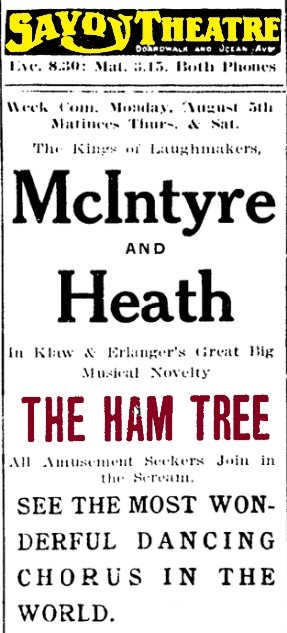
The musical returned to touring, and arrived back at the Savoy in Atlantic City on August 5, 1907. Headliners McIntyre & Heath were still on the bill.

On May 24, 1915, Atlantic City saw a revival of the play with the original stars. Again it was back at the Savoy, only now it was named The Cort and managed by impresario John Cort. This was the opening performances of the newly-named Cort. The play clearly was indelibly associated with McIntyre and Heath, who once again headlined. W.C. Fields, however, was then on Broadway as part of The Ziegfeld Follies of 1915 aka The Blue Follies. Coincidentally, the Follies tried out in Atlantic City’s old stomping grounds, Atlantic City. Fields left AC with Z just two weeks before The Ham Tree arrived. While McIntyre & Heath were still corking up, Ziegfeld bravely featured a real man of color - the extraordinarily talented Bert Williams. But that’s another blog.
#The Ham Tree#McIntyre & Heath#Klaw & Erlanger#Atlantic City#Broadway Musical#blackface#W.C. Fields#Cort Theatre#Savoy Theatre#New York Theatre#George V. Hobart#William Jerome#Jean Schwartz#1905#1915
1 note
·
View note
Text
HAVE A HEART
1916-1917
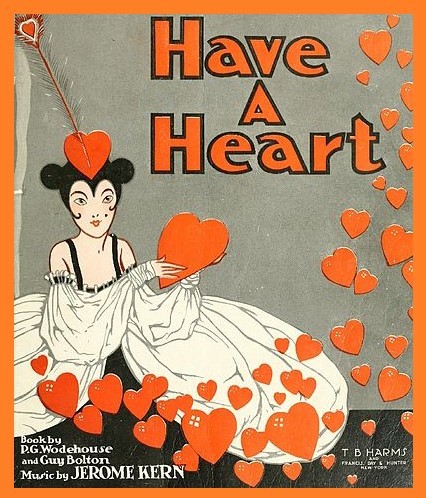
Have A Heart is a musical in two acts and three scenes by Jerome Kern with a book and lyrics by Guy Bolton and P.G. Wodehouse with additional music and lyrics by Schuyler Greene, James Kendis, Charles Bayha and Jerome Kern. It was originally produced by Henry W. Savage and staged by Edward Royce.
Although it did not play the Princess Theatre, it was one of five musicals known as ‘the Princess Musicals.’ At the opening night of the Bolton / Kern collaboration, Very Good Eddie, Kern introduced Bolton to his former collaborator Wodehouse. By the end of the evening, the three had agreed to work together. Their first full collaboration was Have a Heart.
The musical takes place in (fictional) Blueport, Rhode Island in the present (1917). Act I: Lingerie Room at Schoonmaker’s Department Store; Act II: Lounge of the Ocean View Hotel.
Estranged couple Ruddy and Peggy Schoonmaker still love each other, but he is involved with predatory Dolly Barbizon and she is being wooed by confidence man Captain Charles Owen, who is passing forged currency. On the eve of their divorce, Ruddy and Peggy run off together and hide out at the Ocean View Hotel in Rhode Island. Dolly, Owen, and others track them down, and through the quick thinking of the elevator boy Henry, the forger is exposed.
Rehearsals began during the first week in December 1916.
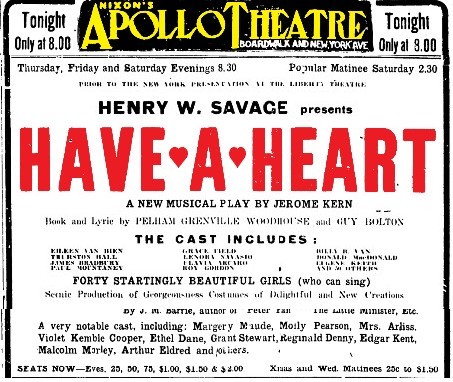
Have A Heart premiered in Atlantic City at Nixon’s Apollo Theatre on the Boardwalk on December 28, 1916. It featured 40 beautiful girls - who could sing!
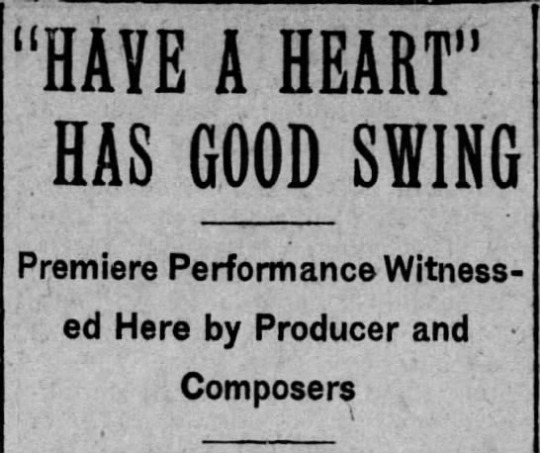
On New Year’s Day, the musical was at the Trent Theatre in Trenton NJ, followed by the Reading Academy of Music in PA (attended by Kern and Bolton), and a single night at the Playhouse in Wilmington DE.
The hit song was the second-act duet “You Said Something” for Ted and Lizzie. Kern himself preferred “And I Am All Alone,” sung by Ruddy and Peggy. The patter song “Napoleon” was recorded by its originator Billy B. Van.
“He was shorn off short,
But was one good sport
And I take after Nap!”

Have a Heart opened on Broadway at the Liberty Theatre (234 West 42nd Street) on January 11, 1917. It played 76 performances.
About the Venue: The Liberty was built in 1904 to present Rogers Brothers musicals. In 1933, it was made over as a movie theatre and continued this function into the 1980s. In 2000, Madame Tussaud's Wax Museum was built on the site. Although the building's exterior is still standing, the interior is no longer in use as a theatre.

"’Have a Heart' never will astound anybody by its originality, but it moves with a swing that is not unlikely to carry it to success in a season when lively musical comedy is in demand. Now and then there is a bright line, and the authors have shown considerable skill in distributing the dullness. Just when it begins to be oppressive someone says something about love being the greatest thing in the world and the orchestra leader gets up and conducts a musical number.” ~ NEW YORK TRIBUNE
“A vacuous and melancholy specimen.... I can discover nothing In the affair worthy of mention.” ~ GEORGE JEAN NATHAN
“Bolton has fallen down on hie dialogue as he usually does for he has a faculty for starting out toward a clever line and then making a miserable failure of It by poor construction.” ~ EMORY B. CALVERT

~ March 11, 1917
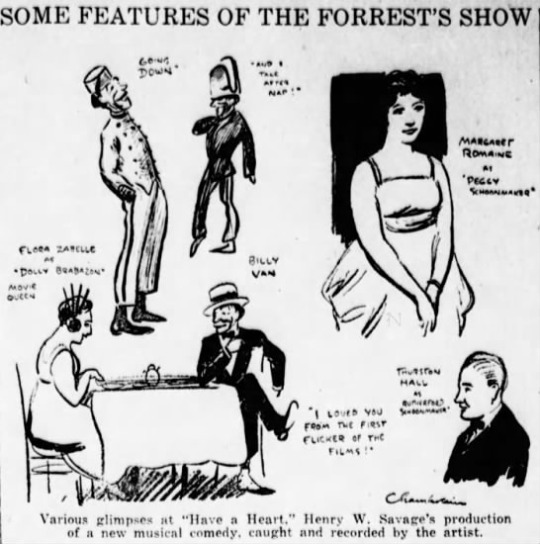
The show played its final performance on March 17, 1917 clocking 76 shows on Broadway. It immediately transferred to Philadelphia’s Forrest Theatre.
In the two years following its Broadway opening, with a Company A and a Company B touring simultaneously, it played in no fewer than 36 states and five Canadian provinces.

Have A Heart returned to Atlantic City at The New Nixon Theatre (later known as The Globe Theatre) on the Boardwalk on April 9, 1917.
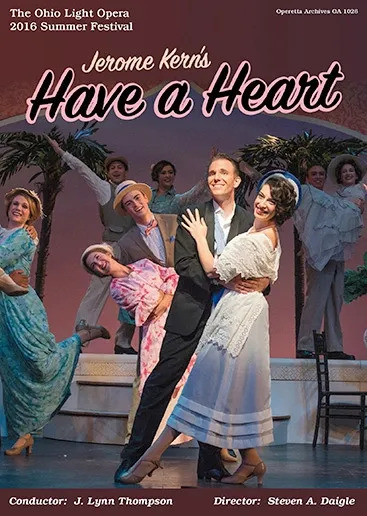
The Victor Light Opera recorded excerpts in 1930. The musical was revived in New York by Musicals Tonight in May 2004. In 2005, Comic Opera Guild released a complete cast recording. In 2016, it was produced by the Ohio Light Opera.
#Jerome Kern#Have A Heart#Broadway Musical#Musical Comedy#Princess Musicals#PG Wodehouse#Guy Bolton#Atlantic City#Nixon's Apollo Theatre#New Nixon's Theatre#Boardwalk#1917#Henry W. Savage#musical#Maria Dresser#Flora Zabelle#Billy B. Van
4 notes
·
View notes
Text
HE AND SHE / THE HERFORDS
1911-12 / 1917 / 1919-1920

He and She is a play in three acts by Rachel Crothers. Written in 1909, it was first produced in 1911, then again in 1912 under the title The Herfords, but did not appear on Broadway until late 1919 reverting to the title He and She.
‘He and She’ is about a husband and wife who are both trying to have careers as sculptors. They both submit work to a competition, and the wife wins over the the husband, which he does not take well. The wife ultimately decides to leave her work in order to take care of her teenage daughter who is having issues.
The play was given a reading in Carruthers hometown of Bloomington IL in the summer of 1911.
The first staging of the play premiered in Albany New York in mid-November 1911. From there, it moved to Poli’s Theatre in Meriden CT.
The play was scheduled to tour, with no Broadway aspirations, but by the end of the year, star Viola Allen was cast to take the role (She) originated by Emma Dunn. With Allen, the play now had the requisite prestige and an opening at Broadway’s Maxine Elliott’s Theatre was rumored imminent.
Just after the first of the year, the play was reported to be back in rehearsal at Daly’s Theatre in NYC produced by Liebler & Co.
By January 9th the play was headed to the Plymouth, not Maxine Elliott’s. This is when the title was changed to The Herfords, after the surnames of the he and she of the previous title.
By January 22nd, The Herfords had been diverted to Boston, opening on March 1, 1912. It then moved on to tour in other cities, as far afield as Oregon.
By the end of 1912, Crothers had moved onto to new plays: Young Wisdom, and Ourselves, both of which reached Broadway, placing He and She / The Herefords in cold storage. Broadway saw three more Crothers plays before He and She resurfaced in mid 1917.

On June 25, 1917, the "new” production premiered in Atlantic City at Nixon’s Apollo Theatre on the Boardwalk. It was produced by Harris and Cohen and starred Effie Shannon and Maclyn Arbuckle in the title roles. Several New York managers pronounced it “a fine success.” Cohan and Harris placed the play back in rehearsals with thoughts of an October Broadway opening. In early August Maclyn Arbuckle suddenly withdrew from the cast, taking an opportunity to perform with William Faversham in Shaw’s Misalliance.
Maclyn made a shrewd move because the Crothers play on Broadway in October was titled Mother Carey’s Chickens, not He and She. In November 1917 a new Crothers play premiered in Atlantic City titled Once Upon a Time. It, too, moved to Broadway and once again, He and She fell by the wayside.
In June 1919, the play resurfaced again - Crothers’ resume considerably bolstered. She now wished to act as well as write. Interestingly, the play had already been released for stock and amateur performances some time earlier.

At the start of the 1919-20 season the Shuberts announced their intention to produce He and She for Broadway, calling it a “new play.” In this production, Crothers herself took the role of Mrs. Herford (aka She), and Cyril Keightley played Mr. Herford (He), with film star Faire Binney in the mix. The role of Mrs. Herford was supposedly based on Carruthers’ mother. The play launched a pre-Broadway tryout tour in Baltimore in June 1919.
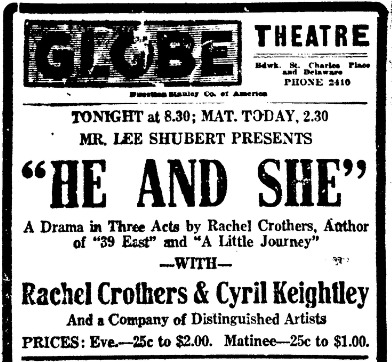
On its way to Broadway, the play stopped (again) in Atlantic City at the Globe Theatre on the Boardwalk on February 9, 1920. It moved immediately (24 hours later), to Broadway.

He and She (finally) opened on Broadway on February 12, 1920 at the Little Theatre (now the Hayes) 240 West 44th Street, Broadway’s smallest and most intimate venue
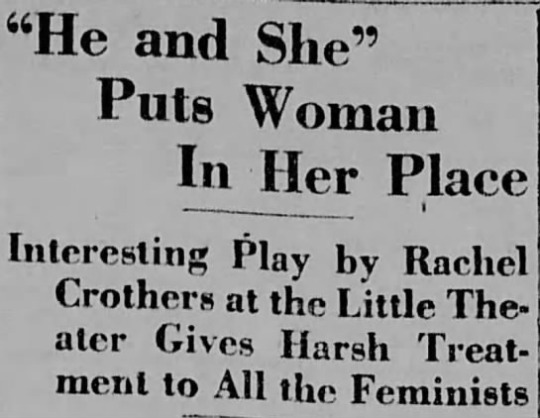
“Miss Crothers herself played pert of the artist's wife. Under strain of being author and leading lady too she was visibly nervous. In her quieter scenes she was excellent but when was called upon to played the tenser moments she played hard and hammered her lines with rather disturbing vehemence. Cyril Keightley gave an excellent performance, but the rest of the cast was not very good.” ~ HEYWOOD BRAUN
“The authoress acts well, although in the more exciting moments she is crude and overplays." ~ BROOKLYN TIMES UNION
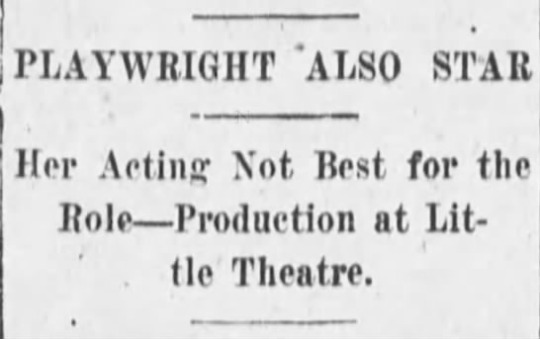
” The staleness of some of the sentiments might justify the rumor of the play's age, but It would not have been enlivening at any period.” ~ THE SUN & NEW YORK HERALD
“’He and She' seems peopled less with folks than with embodied points of view, and the play seems less a dramatic story than a symposium." ~ ALEXANDER WOOLCOT

On March 21, 1920, Crothers wrote a letter to the editor of The Tribune to take issue with the manipulation of an interview she gave with the newspaper. She claimed the author characterized her unfairly and manipulated her words about the New York critics.
He and She closed on Broadway after just 28 performances. Crothers continued to write and direct on Broadway until 1943, scoring more than a dozen more new plays but she never acted on Broadway again.
#He and She#Rachel Crothers#The Herfords#Broadway#Broadway Play#Atlantic City#Feminism#Stage#Globe Theatre#Nixon's Apollo Theatre#Little Theatre
2 notes
·
View notes
Text
SEE SAW
1919 - 1920

See-Saw is a musical in two acts by Louis A. Hirsch (music), book and lyrics by Earl Derr Biggers. It was originally produced by Henry W. Savage, directed by John McKee with musical staging by Julian Alfred.
The musical is based on the novel and un-produced non-musical play Love Insurance by Earl Derr Biggers.
Cynthia Meyrick, daughter of Spencer Meyrick. a wealthy Detroit auto manufacturer, has promised to marry Lord Harrowby, a rattle-brain spendthrift. Although he owns a yacht, Harrow has debts and his creditors show no mercy. Harrowby induces Lloyds to insure him against the loss of Cynthia. Lloyds American agent, Richard Minot, assures the home office that be will never leave Lord Harrowby until he is married to Cynthia. Minot has no idea that Cynthia is the girl he met and fell in love with in France without learning her name. The discovery comes when Harrowby's yacht, with wedding party and guests aboard, is setting sail. In Florida, there are more complications, including a demand by Cleo Ray, an actress with whom Lord Harrowby had an affair some years back.
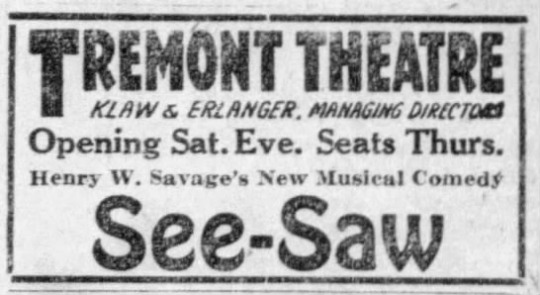
See-Saw had its world premiere in Boston MA at the Tremont Theatre on August 2, 1919. An actors’ strike threatened to prematurely close the show. Savage filed injunctions and threatened legal action against anyone striking.

See-Saw opened on Broadway on September 23, 1919 at the George M. Cohan Theatre (1482 Broadway at West 43rd Street). It was originally scheduled to open on the 22nd, but was delayed a day.
About the Venue: It was built in 1911 by George M. Cohan and Sam Harris. It was sold in 1915, but it was lost to the bank in a mortgage settlement in 1938, and was torn down
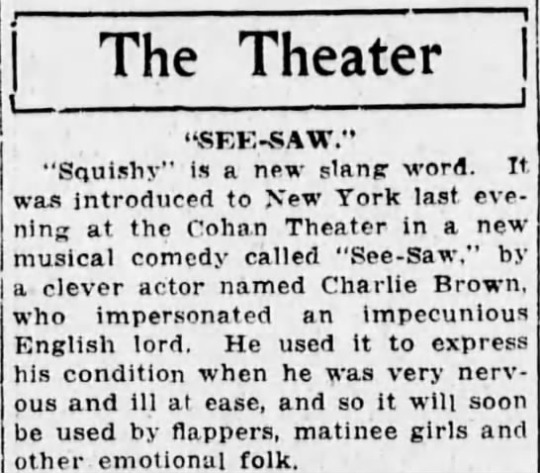
In addition to introducing the word ‘squishy’, the production was also praised for innovating the ‘student chorus’, one which used singers as understudies for the leading role, training them for future stardom.

Most critics praised Der Biggers book, but found the songs trite and familiar by comparison. Some critics carped about the multiple encores of the song “When Two Hearts Discover.” One newspaper (the World) numbered the repetitions as a dozen!

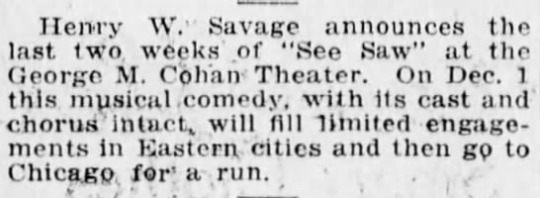
See-Saw closed on December 1, 1919 with 89 performances.
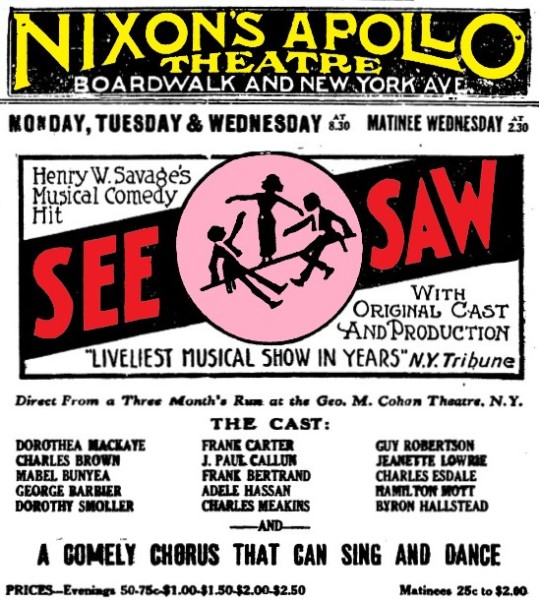
The musical opened in Atlantic City at Nixon’s Apollo Theatre on December 29, 1919.
#See-Saw#Henry W. Savage#musical#Broadway Musical#Atlantic City#Nixon's Apollo Theatre#George M. Cohan Theatre
4 notes
·
View notes
Text
ALL SOULS’ EVE
1920
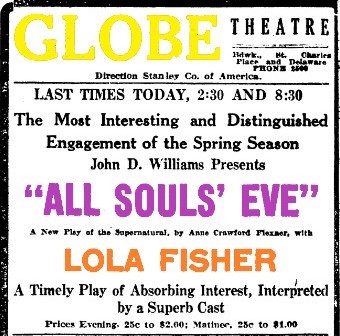
All Souls’ Eve is a play of the supernatural by Anne Crawford Flexner. It was originally produced by John D. Williams, staged by Homer Saint-Gaudens starring Lola Fisher in the dual role of Alison and Norah.
The play is set in Jim Heath's Study, the Nursery, the Lanai of Jim's home on Mt. Tantalus outside Honolulu, on all Soul's Eve
Norah O’Donnell is a young girl living in Ireland. She believes that on All Souls' Eve the spirits of the dead return to visit those whom they loved in life. Norah sails to American to join her mother, but finds that her mother has died. Norah takes up a position as a nursemaid with the Heath family. Jim Heath and his wife Alison have one young son, Peter. Olivia Larkin is in love with Jim, and desperately jealous of Alison. When she finds that she is unable to lure him away from his wife, she convinces a madman that Alison is the one responsible for his misfortunes. The madman murders Alison, and Jim, devastated by his wife's death, neglects his work and his son, turning to drink and Olivia for solace.
On All Souls' Eve, Peter falls seriously ill. Norah tries to rouse Jim, but he is too drunk to respond. She sends for a doctor, but before he can arrive, the soul of Alison appears and, unable to save her son herself, transfers her love for him into Norah, who saves Peter's life. After this, Jim finds that Norah becomes ever more like Alison and shuns Olivia and drink as he comes to realize that he loves Norah. Olivia is pursued to her death by the madman, and Norah becomes Jim's wife and mother to Peter.
About the Title: All Souls' Day, also known as the Day of the Dead, is a day of prayer and remembrance for the faithful departed, which is observed by Roman Catholics and other Christian denominations annually on 2 November.
All Souls’ Eve premiered on April 19, 1920 in Washington DC at the Shubert-Belasco Theatre. It was a benefit for the Women’s Clubs. It then played the Grand in Wilkes-Barre PA and the Lyric in Allentown.

All Souls’ Eve opened in Atlantic City at the Globe Theatre on the Boardwalk on April 29, 1920. From AC the play moved to the Court Square Theatre in Springfield MA.

All Souls’ Eve opened on Broadway at Maxine Elliott’s Theatre (109 West 39th Street) on May 12, 1920.
About the Venue: Lee Shubert sold actress Maxine Elliott the land for this theatre in exchange for fifty-percent interest in it - making Elliott one of the only female managers. It was leased to the Federal Theatre in 1936. In 1941, it became a radio station and, later, a television studio. In 1956, Elliott's heirs sold her share to the Shuberts, who then sold the property. It was demolished in 1960.
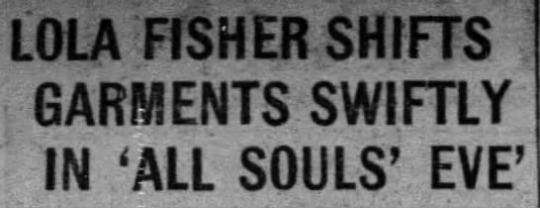
“One moment a vocal wraith, swathed in misty chiffons, Miss Fisher floats about; and having wafted herself gracefully behind the screen which, the audience is told to believe, shields the couch of the sleeping nurse, she delivers Norah’s lines from that vantage point. The scene seemed to me to be handled with excessive clumsiness, although I scarcely see how it could have been done otherwise.” ~ McELLIOTT, NY DAILY NEWS

“Its defects are verbosity and Mrs. Flexner's inability to maneuver her plot with anything approaching dexterity. Most of the dialogue is flat, devious and uninteresting. It tells the story at a snail's pace, with many delays and considerable stuttering.” ~ BROOKLYN DAILY EAGLE
The play closed at Maxine Elliott’s on June 12th after 21 performances.

In 1921, the play was filmed starring Mary Miles Minter. Much was made of the film's use of double, triple and quadruple exposures to enable Minter to play two parts within the same scenes. It is now thought to be a lost film.
In reviewing the play, Heywood Braun said:
“The Flexner play was financed by some of that awful ‘movie money' we have heard so much of lately and is unquestionably designed for screen use later - Furthermore, It will make a better picture than It does a play.”
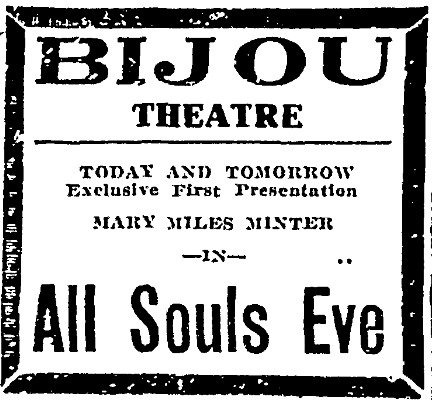
The film opened in Atlantic City at the Bijou Theatre on the Boardwalk on March 14, 1921.
#All Souls' Eve#Mary Miles Minter#Lola Fisher#Broadway#Broadway Play#Globe Theatre#Bijou Theatre#Maxine Elliott's Theatre#Atlantic City#Boardwalk#1920
3 notes
·
View notes
Text
LOVE O’ MIKE
1916 - 1918

Love O’ Mike is a musical comedy in two acts and a prologue by Jerome Kern (music), Harry Smith (lyrics), and a book credited to Thomas Sydney (a pseudonym for Augustus Thomas and Smith’s son Sydney) with additional lyrics by Herbert Reynolds. It was originally produced by Elizabeth Marbury and Lee Shubert, staged by J.H. Benrimo. The cast featured Lawrence Grossmith (Lord Michael Kildare), Allison Bain (Mrs. Marvin), George Hassell (Bif Jackson), Clifton Webb (Alonzo Bird), Vivian Wessell (Vivian), Luella Gear (Luella) and Peggy Wood (Peggy), among others.
The musical was formerly titled Girls Will Be Girls. It was changed to avoid confusion with another musical of the same title. Love O’ Mike was one of the script’s original titles along with Strike the Lyre.
The musical takes place at Mrs. Marvin’s home in Bronxville, New York.
All the girls at Mrs. Marvin’s house party fall in love with Lord Michael Kildare (the Mike of the title), but he only has eyes for Vivian. The party is marred when the butler, a sometimes second-story man, steals one young lady’s money. Then Mike takes credit for rescuing people from a local tenement fire. His bravery further mars the fun of the male members of the party, who must endure watching their girls’ adulation of Mike run out of control. With the butler, the men plot a phony rescue to counter Mike’s claims of heroics. But the two-faced butler tells Mike and the girls of the plan.
Under the title Girls Will Be Girls, the show premiered at Philadelphia’s Lyric Theatre on November 20, 1916. In January 1917 it played the Garrick in Detroit and the Alvin in Pittsburgh.
“All the familiar conventions associated with musical plays have been swept aside in the production of ‘Love O' Mike.’ There is no chorus, but there is a cast of sixteen principals; the music helps to develop the story and there is a freshness and spontaneity about the individual performances that aid in the appeal of the entertainment.” ~ COURIER-NEWS

Love O’ Mike opened on Broadway at the Shubert Theatre (255 West 44th Street) on January 15, 1917.
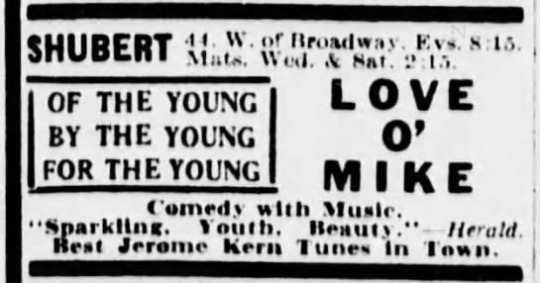
About the Venue: The Shubert Theatre was built by Lee and J.J. Shubert as tribute to their brother Sam, who died in a train crash in 1905. It has rarely been dark since opening in 1913. It is the flagship theatre of the Shubert Organization.
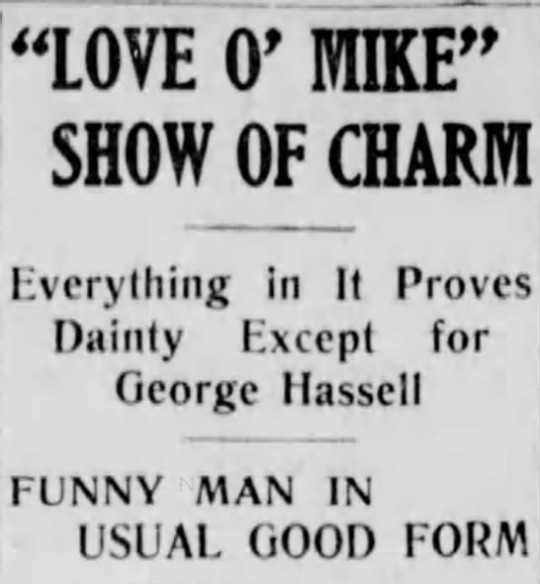
"’Love O’ Mike' is an excellent musical comedy for a pair of beginners, but when that has been said there remains little else that may be stated its favor. With due consideration for their youth and Inexperience, the piece is still disappointing because they had such excellent advisers.” ~ NEW YORK HERALD

The musical transferred to Maxine Elliott’s Theatre (109 West 39th Street) on March 19, 1917 and played there until June 30, 1917.

About the Venue: Lee Shubert sold actress Maxine Elliott the land for this theatre in exchange for fifty-percent interest in it - making Elliott one of the only female managers. It was leased to the Federal Theatre in 1936. In 1941, it became a radio station and, later, a television studio. In 1956, Elliott's heirs sold her share to the Shuberts, who then sold the property. It was demolished in 1960.

After taking the summer months off, the musical re-opened on August 27, 1917 at the Casino Theatre (1404 Broadway at 39th Street). Laurence Grossmith was replaced by Max Leeds, but much of the original cast remained. This relaunch would technically be kicking off a new theatre season. It played there until September 29, 1917.

About the Venue: Built for light musicals and operetta, the Casino showed mostly "polite vaudeville" starting in 1892. In 1903 the Shuberts acquired the lease. A 1905 a fire necessitated much reconstruction. In February of 1930, the theatre was demolished to make room for the expanding garment district.
The total run over all three theatres was 233 performances. After Broadway, the play decamped to Newark before moving to Buffalo and Boston.
The play toured extensively and eventually made its way to Atlantic City.

Love O’ Mike opened in Atlantic City on May 20, 1918 at B.F. Keith’s Garden Pier Theatre. The tour finally wrapped up in June 1918, 19 months after its first performance in Philadelphia.
#Love O' Mike#Jerome Kern#Shubert#Garden pier Theatre#Atlantic City#Peggy Wood#Laurence Grosssmith#George Hassell#Clifton Webb#Musical#Broadway Musical#Musical Comedy#Girls Will Be Girls#Shubert Theatre#Casino Theatre#Maxine Elliott's Theatre
4 notes
·
View notes
Text
THE UNSEEN HAND / THE OUIJA BOARD
1920

The Ouija Board (previously known as The Invisible Hand) is a play in three acts by Crane Wilbur. It was originally produced by A.H. Woods and staged by W.H. Gilmore starring Alma Belwin and Mr. Wilbur (above).
The supernatural themed play was billed as a “play of the seen and unseen.” This was Wilbur’s first play on Broadway as a playwright. Rehearsals began in late January 1920.

About the Title: A Ouija board, also known as a spirit board or talking board, is a flat board marked with the letters and numbers along with various symbols and graphics. It uses a planchette (small heart-shaped piece of wood or plastic) as a movable indicator to spell out messages during a séance. Participants place their fingers on the planchette, and it is moved about the board to spell out words. "Ouija" is a trademark of Hasbro, but is often used generically to refer to any talking board.
The play takes place in the library in Henry Annixter's house and a room in Gabriel Mogador's house in a large manufacturing town in the upper part of New York State.
A woman who is left too much alone deserts her husband for another man, who in turn deserts her. Her husband condones her fault and she returns to him, but lives only a short time, leaving a little boy, the father of whom betrayed her. Her betrayer finally lands In prison, and after his release disguises himself as a spiritualistic medium and starts swindling the people of a large town by purporting to receive communications from the dead. Among his victims is the man whom he has wronged, and who believes he can communicate with his dead wife through the writing stunt. The mind of the faker becomes so unsettled that he Imagines he sees the woman's spirit and unconsciously reveals his identity In the writing. His patron becomes enraged and plunges a dagger in his back, killing him. When discovered, the dead man's hand is resting on the pad, and the message of the dead helps to solve the second crime, that of the killing of the man who killed the medium. The perpetrator of the latter tragedy is none other than the medium’s son, a dope fiend, who expected to marry the daughter of his benefactor, who inherited her father's fortune.

As The Unseen Hand, the play opened in Atlantic City at the Globe Theatre on February 16, 1920.

It was next seen at the Lyceum in Paterson NJ on March 26th and 27th.
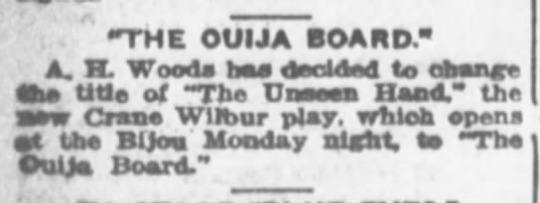
After this engagement, producer Woods changed the play’s title to The Ouija Board, despite it having a very small part in the action of the play.
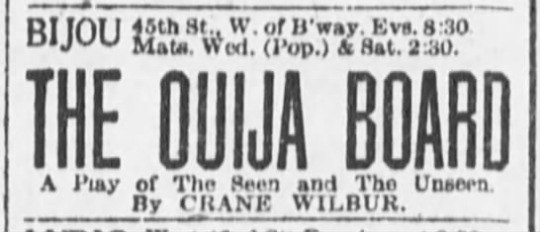
The Ouija Board opened on Broadway at the Bijou Theatre (209 West 45th Street) on March 29, 1920.
About the Venue: The Bijou Theatre was built in 1917. In 1935, it became New York's first all-cartoon cinema, beginning a rotating cycle during which the house alternated between legit and movie presentation (except when it was dark from 1937 to 1943). In 1959, the adjoining Astor was renovated and acquired a large chunk of the Bijou's space. It reopened as an art cinema in 1962. Intermittent legit productions followed until the theatre was demolished in 1982, making room for the Marriott Hotel.

“One of the devices of the play which surprised but did not altogether please us was an electrical device installed n a phonograph by which anybody who played "Fair Harvard' would be shot in the chest. It served to kill one character in the play and another barely escaped. We would have found it more pleasing and convincing as well, if he had died from ‘Boola Boola’ or ‘Old Nassau.’“ ~ HEYWOOD BRAUN


The play ran 64 performances at the Bijou closing on May 23, 1920. On Monday, May 25th the play decamped to Boston’s Plymouth Theatre where it quietly departed this theatrical world after a brief run.
#The Ouija Board#The Unseen Hand#Crane Wilbur#Broadway Play#Broadway Theatre#Atlantic City#Supernatural#1920#Theatre#Plays
2 notes
·
View notes
Text
PETTICOATS / A PAIR OF PETTICOATS
1918
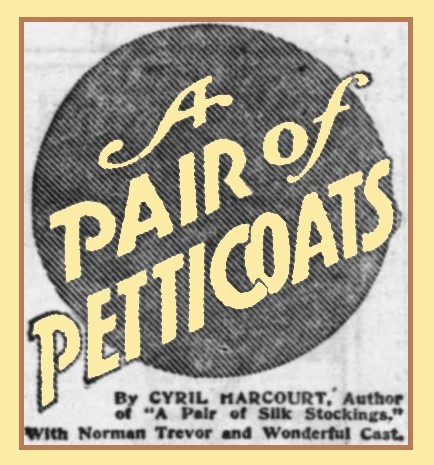
A Pair of Petticoats (originally Petticoats) is a three act play by Cyril Harcourt. It was originally produced by the Shuberts and directed by the author starring Norman Trevor. The cast also included Henry Travers, Laura Hope Crews, and Mr. Harcourt.
The author seems obsessed with ladies undergarments. In 1914 he wrote and starred in the Broadway hit A Pair of Silk Stockings. In rehearsals, the play was titled The Hungry Fish.
About the Title: In both historical and modern contexts, petticoat refers to skirt-like undergarments worn for warmth or to give the skirt or dress the desired attractive shape.
Set in England, "A Pair of Petticoats" concerns the love trials and tribulations of a young English nurse who has returned to London on a short furlough. While there, she meets a former friend of the trenches who is also at home, recovering from an attack of enemy gas. As the setting is perfect for a proposal, the injured soldier pops the question and is accepted, but shortly after he leaves his fiancée another woman appears on the scene, who unfolds an alarming tale of his past. The convalescent starts for America to forget his troubles, and when he is supposed to be half way over his sweetheart learns of the other woman's mistake in his identity. Just as life seems black and empty, Sir Rupert, a friend of the family, steps in and saves the day.

Petticoats (the original title) opened in Atlantic City at Nixon’s Apollo Theatre on February 18, 1918. It is worth noting that when Harcourt’s A Pair of Silk Stockings tried out at the same venue in December 1914, it was NOT simply titled “Silk Stockings”! The title change from Petticoats to A Pair of Petticoats was announced immediately after this engagement, before the play moved to Stamford and New Haven CT.
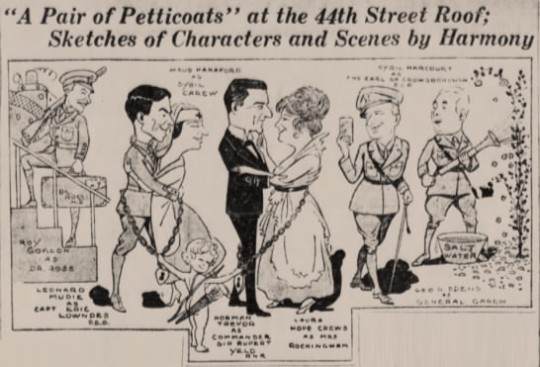
A Pair of Petticoats opened on Broadway at Lew Field’s 44th Street Theatre Roof Garden on March 18, 1918.
About the Venue: Built in 1913, the roof garden of Weber & Fields' Music Hall changed its name nine times in twenty-four years. During the 1930s, it presented Federal Theatre Project shows, as well as marionette, amateur theatre, and dance companies. In 1940, it was bought by the New York Times company and was demolished in 1945 to accommodate the Times' expansion.
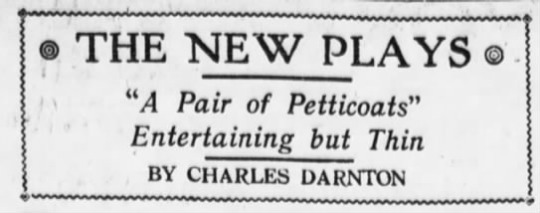
“To dramatize lingerie is a feat that would be attempted only by the bravest of men, even though he worked a Red Cross nurse into his war-time scheme of things.”

“If [Harcourt] Intends to dramatize all the articles of lingerie on the feminine laundry list he will be busy for some seasons and luckily not have to worry about the selection of subjects for his masterpieces.” ~ NEW YORK HERALD

On April 22, 1918, the production transferred to the Bijou Theatre (209 West 45th Street) where it closed on May 25th after 80 performances.
About the Venue: The Bijou Theatre was built in 1917. In 1935, it became New York's first all-cartoon cinema, beginning a rotating cycle during which the house alternated between legit and movie presentation (except when it was dark from 1937 to 1943). In 1959, the adjoining Astor was renovated and acquired a large chunk of the Bijou's space. It reopened as an art cinema in 1962. Intermittent legit productions followed until the theatre was demolished in 1982, making room for the Marriott Hotel.
After Broadway, the play decamped to Chicago where it played the Studebaker from June 2nd with most of the original Broadway cast. It closed there on July 29th.
FILM FUTURES
Although two films were made of A Pair of Silk Stockings, A Pair of Petticoats was never filmed.
Actor Henry Travers is probably best remembered for playing Angel Clarence in Frank Capra’s It’s A Wonderful Life (1946). He was nominated for an Oscar for Mrs. Miniver in 1942.
Laura Hope Crews is probably best remembered for playing Aunt Pittypat in Gone With The Wind (1939).
#A Pair of Petticoats#Petticoats#Broadway#Broadway Play#Atlantic City#Henry Travers#Laura Hope Crews#Norman Trevor#Cyril Harcourt#1918
1 note
·
View note
Text
UNDER FIRE
1915
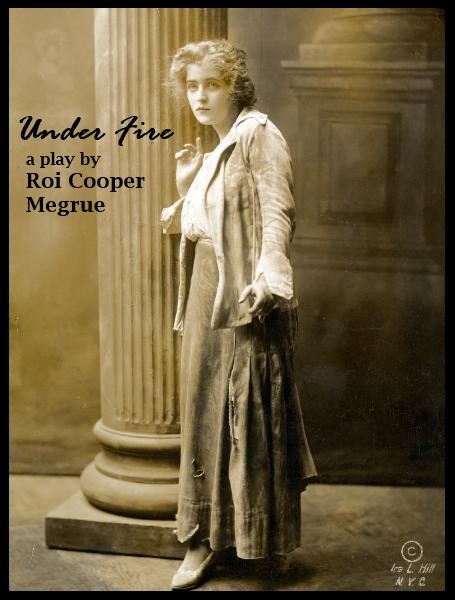
Under Fire is a play by Roi Cooper Megrue. It was originally produced by Selwyn & Company and co-directed by Megrue and its star, William Courtenay. The original production also featured Violet Heming (above), Frank Craven (who played an American reporter named Charlie Brown), and, in the ensemble, Edward G. Robinson.
The play was presented in London the previous season. At the time of production, the United States had not yet officially entered World War One (aka ‘The Great War’) which didn’t happen until April 6, 1917.
The play was billed as “a new play of today, tomorrow, and yesterday.”

This was the second of Megrue’s “Under” plays. The first was 1914′s hit Under Cover, and the third, and least successful, was 1916′s Under Sentence. All three were produced by Selwyn and Co. The first two were seen in Atlantic City featuring William Courtenay.

Megrue, however, denied that the use of the ‘Under’ titles was intentional. The plays are thematically unrelated. However, creating a third title containing ‘Under’ makes it difficult to claim it was not intentional.
"Under Fire" concerns itself with an adventurous and lovable young Irishman, (William Courtenay), who, finding himself in England at the beginning of the war after several years of foreign service, goes to Belgium with the first expeditionary force when England declares war. In England, he rediscovers the woman he loved, whom he had left years before because his poverty prevented him asking her to exchange her life in the most exclusive London society, where both her wealth and her charm placed her, for the nomadic existence of the wife of a young officer. By a striking chain of events, she finds herself In a position where she cannot accept his suit, nor tell him why, but she promises that in the great war game he is entering she will help him. The very circumstance which prevents her from becoming engaged to the Irish captain sends her into Belgium almost as soon as he goes. They meet, and to all appearances, are on opposite sides of the great struggle.
It was claimed that the company for the played number 150 with 50 speaking parts.
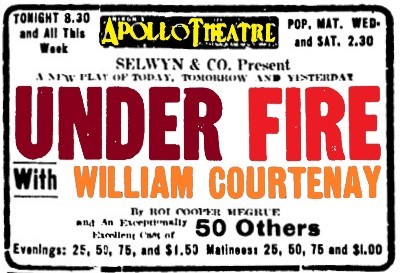
Under Fire premiered in Atlantic City at Nixon’s Apollo Theatre on the Boardwalk on May 24, 1915. Unusually, the play held an invited dress rehearsal for actor and managers who could not be away from New York City on its opening night.


On August 5th, the play was seen at the Broadway Theatre in Long Branch NJ.

Under Fire opened on Broadway on August 12, 1915 at the Hudson Theatre (141 West 44th Street).
About the Venue: The Hudson was bult in 1903. It was most often used as a TV studio in the 1930s, 40s, and 50s. In 1974, it was a blue movie theatre. In 1980, it became the Savoy, a rock club. In 1987, it received landmark status, so it was incorporated it into the adjacent Millennium Broadway Hotel as a conference center and auditorium. The venue re-opened as a legitimate Broadway theatre in 2017.

Like Under Cover, a novelization of the play was published in 1916, It was co-authored by Richard Parker, published by The Macaulay Company. The book was serialized for newspapers.
“In order to discourage the audiences at the Hudson Theater from taking sides during the performances of Roi Cooper Megrue’s ‘Under Fire,’ Selwyn and company have inserted a notice in the program requesting that no member in the audience indulge in any unpleasant demonstrations which might be offensive to others in the audience, or to those on the stage.” ~ BROOKLYN DAILY EAGLE

"’Under Fire’ may well be Judged by German sympathizers as out-and-out anti-German propaganda. With probably the best Intentions in the world, and with an apparent effort to be fair at least, Mr. Megrue has nevertheless moved a load of dynamite into the Hudson Theater and placed it under fire.” ~ BROOKLYN DAILY EAGLE
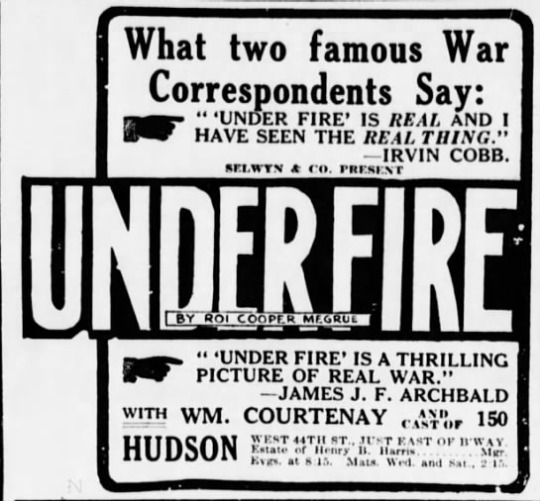
“’Under Fire’, while dealing with certain phases of the Great War, attempts to be neutral, although its characters being English, Belgian, French, and German, are naturally partisan.” ~ Samuel French Acting Edition of the Play, 1918

“[The trench scene] is a masterpiece of the stage architect. As one critic put it, ‘A sky brilliant with stars, a soldiers’ game of cards, the sentries on watch, the bursting of bombs and signal lights, and finally the aerial mine that ends all —Belasco never created anything more perfect.’” ~ BRETT PAGE, AUSTIN AMERICAN STATEMENT
Although Belasco was noted for his plays’ technical proficiency, he did not like Megrue’s writing. He must have changed his mind, however, because he produced Megrue’s play Seven Chances, which ran concurrently with the third ‘Under’ play Under Sentence in the second half of 1916.
The Broadway production of Under Fire ran for 129 performances, and then decamped to Boston’s Park Square Theatre. From there it embarked upon a tour of the North East: Massachusetts, New York State, and Pennsylvania.
In early 1916, a production opened in Sydney Australia at the Criterion Theatre.

In April 1916, the play was presented in Brooklyn, first at the Shubert, then at the Montauk.
On May 1, 1916 it was presented at Philadelphia’s Forest Theatre. The role of Charlie Brown, formerly played by Frank Craven, was taken by Frank Morgan. By this time, Megrue and Selwyn began planning production of their next Under play, Under Sentence. Also in 1916, Edward G. Robinson made his film debut. It would be the movies, not the stage, that catapulted the actor to fame. In 1973, he posthumously received an honorary Academy Award, accepted by his wife Jane.
#Under Fire#Roi Cooper Megrue#Under Cover#1915#Atlantic City#Broadway#Broadway Play#Edward G. Robinson#Frank Craven#Frank Morgan#Violet Heming#William Courtenay#World War One
2 notes
·
View notes
Text
THE GAY WHITE WAY
1907 / 1908

The Gay White Way is a three act musical revue (review) with music by Ludwig Englander, and book and lyrics by Sydney Rosenfeld and James Clarence Harvey. It was originally produced by Sam and Lee Shubert, staged by R.H. Burnside with dances arranged by Ralph Post.
“The story of ‘The Gay White Way’ concerns almost anything in general and hardly more than nothing in particular.” ~ Frederick Tragellia
The show was a revised and re-written version of the previous season’s hit Wine, Women and Song.

Interpolated songs included:
"Merry-Go-Round" by Louis A. Hirsch and E. Ray Goetz
"Somebody's Been 'Round Here" by John W. Bratton and Paul West
"If You Must Make Eyes at Someone" by Leo Edwards and Matt Woodward
"Dixie Dan" by Seymour Furth and Will D. Cobb
"My Irish Gibson Girl" by Jean Schwartz and William Jerome
“Under the Matzos Tree” by Fred Fisher and Alexander Carr

About the Title: Broadway was known as ‘the Great White Way’ because of the glare of its lighted marquees. At the time, electricity used in signage was new and eye catching. The words “great” and “gay” were then used interchangeably. In the early part of the 20th century and previous, the word gay inferred frivolity, light-hearted fun, not homosexuality, as it does today.
The revue satirized past and present Broadway hits and locations. Performers played such real-life Broadway luminaries as David Belasco, Alla Nazimova, Eddie Foy, Trixie Friganza (played by her own sister Bessie), Anna Held, Henry Anglin (portrayed by his own son J. Heron), and Margaret Anglin.
"What Is the Gay White Way anyhow?" ~ a November 1908 newspaper article
The Gay White Way - meaning Broadway - is the greatest street In the world. It is a path of pleasure and a morgue of misery, a boisterous boulevard, a mainspring of mirth. Here are the definitions given by the stars and some of the principals of "The Gay White Way":
Jefferson DeAngelis - The Gay White Way is a riot of roses and a ramble of remorse.
Blanche Ring - The Gay White Way is a condition of minds and contradiction of theories.
Alexander Carr - The Gay White Way is the only place where every chorus girl owns an automobile.
Maude Raymond - The Gay White Way is the street on which, if you leave it for season, you will return singing "Somebody's Been Around Here Since I’ve Been Gone.”
Laura Guerite - The Gay White Way is a continuous Tiddly Om Pom. It is a hash of happiness and a goulash of gaiety.
Frank Doane - The Gay White Way is nothing more than a gigantic lemon squeezer, and many a lemon it has squeezed.
The production had its world premiere in Philadelphia on September 23, 1907.
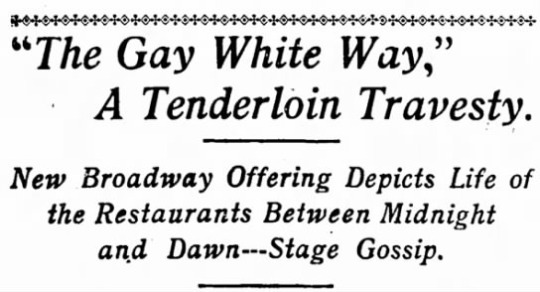
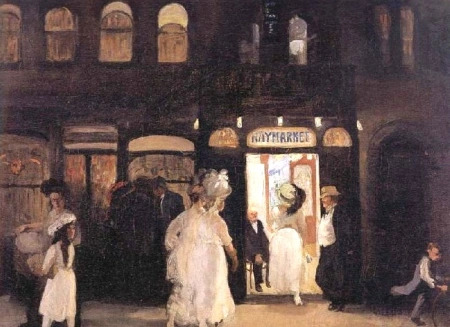
Scenes took place in the Tenderloin, an entertainment and red-light district in the heart of Manhattan during the late 19th and early 20th centuries. The area originally ran from 24th Street to 42nd Street and from Fifth Avenue to Seventh Avenue. In 1960, a Broadway musical titled Tenderloin was set in the district during the 1890s.

The Gay White Way opened on Broadway at the Casino Theatre (1404 Broadway at 39th Street) on October 7, 1907. It was the follow-up to a previous musical revue titled Wine, Women, and Song.

About the Venue: The Casino Theatre was built in 1882 for light musicals and operetta, but showed mostly vaudeville starting in 1892. A 1905 fire necessitated much reconstruction. In February of 1930, the theatre was demolished to make room for the expanding garment district.
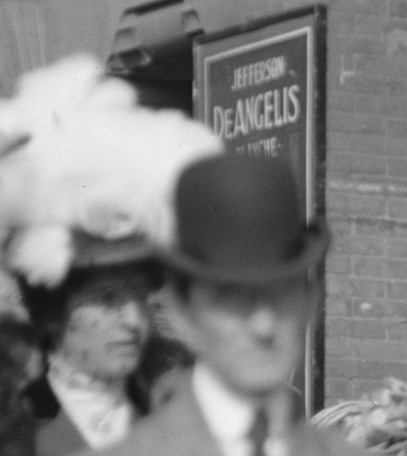
A sign outside the Casino lists Jefferson DeAngelis, who played George Dane in the show.

Another sign outside the Casino indicates that Alexander Carr was appearing. He played Montgomery Bernstein Brewster.
[Thanks to the Stuff Nobody Cares About blog for the close-up images]

“A musical comedy stew filled with everything these theatrical cooks, Messrs. Sydney Rosenfeld and Ludwig Englander, could put in it. But one of these men, in cutting up the ingredients, must have dropped in a lemon or two. While the first helping tasted good to a large audience, the second and third act helpings needed large doses of Worcestershire sauce, and then it wasn’t altogether as palatable as had been expected from a peep in advance at the menu before the curtain went up.”

On October 16th it was reported that changes were afoot at The Gay White Way.

This song is not listed as part of opening night, but was probably inserted after the show opened. Featured performer Alex Carr was its author and originator.

On October 26th, a gun misfired onstage injuring Blanche Ring.

On November 18th, a US Senator’s ex-wife joined the cast. Claire Oddie performed under her maiden name of Claire MacDonald. Her ex-husband Tasker Oddie became the 12th Governor of Nevada in 1911 and was one of those who signed the charter for the new city of Las Vegas.
The Gay White Way closed on January 4, 1908 after 105 performances. It began a limited tour in Philadelphia, where it first opened.

On May 29, 1908, The Gay White Way finally played The Gay Wooden Way, appearing at Nixon’s Apollo Theatre in Atlantic City NJ. Original stars Jefferson DeAngelis, Blanche Ring, and Alexander Carr were still performing in the show. The show they performed, however, looked very different than the one that opened in nearby Philadelphia in late September 1907.
#The Gay White Way#Broadway#Broadway Musical#1907#Atlantic City#Nixon's Apollo Theatre#Casino Theatre#Jefferson D'Angelis#Blanche Ring#Alexander Carr#musical revue#musical#Tenderloin#New York City
1 note
·
View note
Text
LADIES’ DAY
1920

Ladies’ Day is a three-act satire by Edward Peple. It was originally produced and directed by H.H. Frazee.
A breach of promise case comes to trial before the first jury ever seated in any courtroom In the the United States consisting entirely of women, and is argued pro and con by two women lawyers.
The cast consisted of 30 performers, 21 of which were speaking roles. 17 of them were women.
In 1920, the fight for women’s rights was fought on a state-by-state basis. In New Jersey and Pennsylvania, women were not allowed on juries until 1921, a year after the play was performed.

“Studies in Expression. When Women are Jurors”, drawn by Charles Dana Gibson in 1902. The idea of women sitting on juries in the United States was subject to ridicule up until the 20th century.
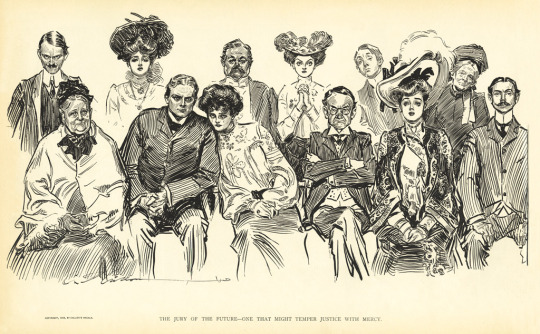
The following year the same artist followed up with "The Jury of the Future. One that Might Temper Justice with Mercy" (1903). It was thought that women were more compassionate than men, an idea that still exists today.

H.H. Frazee had previously produced Edward Peple’s hit play A Pair of Sixes, which scored 277 performances on Broadway in 1914. Peple’s next play on Broadway, Friend Martha in 1917, was a flop, closing after 15 performances.
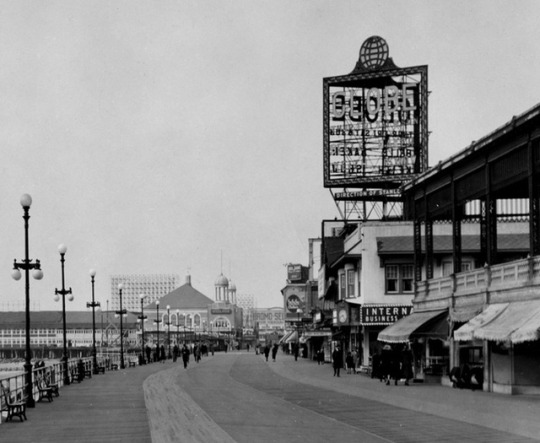
Ladies’ Day premiered in Atlantic City at the Globe Theatre on the Boardwalk on April 26, 1920. It shared the front end of a split week with All Souls Eve, a supernatural play by Anne Crawford Flexner.

Like so much about the play, it is unclear whether the above listing as Ladies’ Night was a title variation, an error by the Globe Theatre, or a typesetting error at the newspaper. The official title, however, was Ladies Day, not Night. It is ironic considering a play by that title went on to great success on Broadway - something not in the cards for Peple’s play.

Sadly for Miss Bristow, the play never reached Beantown or the Big Apple.
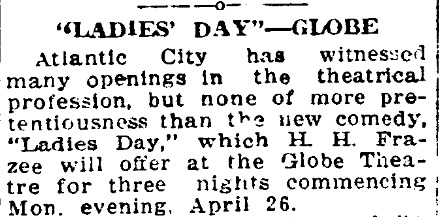
It appears that the ‘futuristic’ idea of a play with an all-female jury and lawyers was greeted with winking derision by the press.
“The play is the best example of real satiric comedy our stage has seen in a long time.” ~ ATLANTIC CITY PRESS

“While the author has not written a great play here, he makes us all grateful for a clean, bright travesty that comes as a grateful relief to the bedroom type of risqué farce that has held our stage for so long.” ~ ATLANTIC CITY PRESS

Shortly after Ladies’ Day premiered in Atlantic City, Frazee made headlines by purchasing Fenway Park in order to save it from bankruptcy. In January 1920, as owner of the Boston Red Sox, Frazee sold their prize player, Babe Ruth (above), to the New York Yankees, thus initiating the legendary ‘Curse of the Bambino’ for the Red Sox. It was well known that Frazee’s baseball dealings helped finance his theatrical endeavors, most notably the play that inspired the musical No, No, Nanette, My Lady Friends (1919). Coincidentally, both plays are partly set in Atlantic City NJ.
Even more coincidentally, the term “ladies’ day” in a baseball context was generally when women spectators were encouraged to attend ballgames, sometimes using promotions or give-aways.
Before leaving the Garden State, the play did a night in Paterson at the Lyceum on May 1st. On May 4th it played also single night at the Lyric in Allentown PA. On May 5th, the play was seen in Wilkes-Barre PA at the Grand Theatre.

This gig at the Grand appears to be where the play closed and all involved turned to other pursuits:
In June 1920, playwright Peple contributed his one-act play “The Golden Egg” to the Annual Lambs Club Gambols in New York City. On June 28th, his new comedy Maggie opened in Rochester.
In August 1920, a film version of Peple’s 1905 play The Prince Chap was released. That same month, a play opened on Broadway titled Ladies’ Night, also titled Ladies’ Night in a Turkish Bath. It was a huge hit.
In August 1922, it was announced that Frazee would produce Peple’s play The Little Visitor in Boston, a play set in Virginia just prior to the Civil War. It is unknown if this play was related to or inspired by his 1911 play The Littlest Rebel, which was later made into a successful film starring Shirley Temple.
#Ladies' Day#Edward Peple#H.H. Frazee#Babe Ruth#Baseball#1920#Atlantic City#Globe Theatre#Jury#Suffrage#Satire
88 notes
·
View notes
Text
DAYBREAK
1917
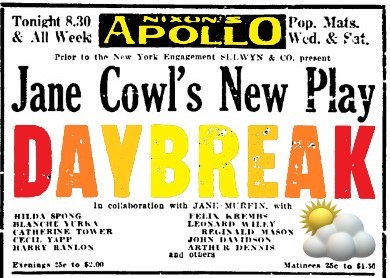
Daybreak is a play by Jane Cowl and Jane Murfin. It was originally produced by Selwyn and Company staged by Wilfred North and Miss Cowl.
Successful businessman Arthur Frome, who drinks too much, pushes a newsboy under an automobile, thus causing him severe injuries. His wife Edith then becomes disillusioned with her husband and leaves him. After an absence of a few years, Edith returns to her husband but offers no explanation of her behavior. Soon, however, Arthur becomes suspicious when she and their family friend, Dr. Brent, frequently visit a house in which a small child is living. Arthur has Edith followed by the wife of one of his employees, whom he has caught stealing, and soon discovers that the child, who is gravely ill, is his own. Edith confesses that she did not want to raise their child under the influence of a drunkard and so left him in someone else's care. Soon after this confession, Arthur is shot by the husband of the woman who has followed Edith because the man suspected his wife of having an affair. Arthur recovers, however, as does the child, and through Dr. Brent's intervention is happily reconciled with Edith, with whom he plans a new life.
About the Title: The play begins at daybreak in a darkened hallway of a New York apartment. Cowl and Murfin were intent on creating the mood of daybreak without resorting to clichés that might result in laughter. They nixed a visit from the milkman and a crowing rooster. They settled on a single shaft of yellow light piercing the darkness of the quiet room. The first scene is played in silence with no dialogue to create the ‘hush’ of early morning.
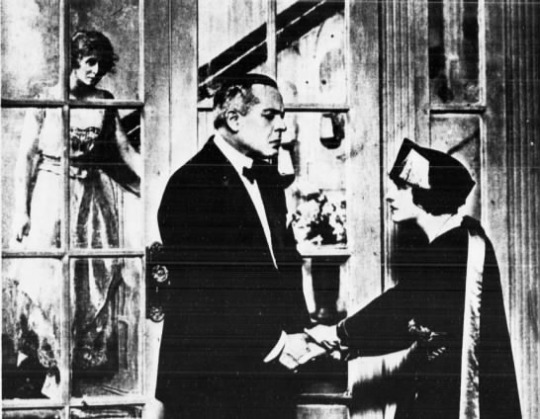
Daybreak premiered in Atlantic City at Nixon’s Apollo Theatre on the Boardwalk on June 18, 1917.
“[The play] was presented to early summer reporters at Atlantic City. It will not, therefore, be an unusual sight in Atlantic City to see a large number of people going home after ‘Daybreak'.” ~ WASHINGTON POST
Edith Frome was played by Blanche Yurka, a performer that Cowl had worked with and promised to help in her career. She was later cast in another play by Cowl and Murfin. Arthur Frome was played by Frederick Truesdell, one of Broadway’s most popular leading men.
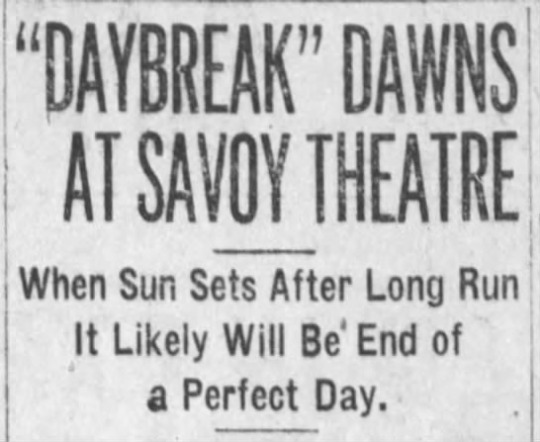
In late July and early August, the play was seen on the Jersey shore in Asbury Park at The Savoy and Long Branch at the Broadway.
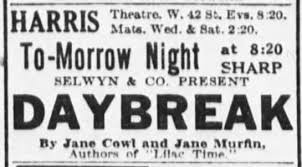
Daybreak opened on Broadway at the Harris Theatre (254 West 42nd Street) on August 14, 1917.
About the Venue: The Harris (named after William B. Harris) was built in 1904 as the Lew Fields Theatre. It was variously known as the Hackett, Wallacks, the Frazee, and finally the Anco Cinema. In 1988, the interior was gutted and it was used as retail space. It was finally demolished in 1997 as part of the 42nd Street redevelopment.

This was the second collaboration between Cowl (above) and Murfin, who previously penned Lilac Time earlier in 1917. Cowl also performed in Lilac Time, which closed on June 9th at The Harris (having transferred from The Republic), allowing Daybreak to move in. Between the two plays, Lilac Time proved the more popular and more successful. In October 1918 they collaborated on a third production, Information Please, with Cowl again performing, which was less successful still. In December 1919, the pair had their most successful script, Smilin’ Through, although they wrote it under the pseudonym Allan Langdon Martin. It inspired two films and two television adaptations. In 1932, Smilin’ Through was the basis for a flop musical titled Through The Years by Vincent Youmans.
"I am really pretty tired," she said. "You see, last summer was a strenuous one. I live at Great Neck on Long Island, and my movie work was done at Fort Lee NJ. I used to get up every morning at 5:30 am and shortly after after 6:30 I was in my car and on my way to Fort Lee. At 7 I was in my dressing room, by 8 I was in the studio. Then it was work until 5 or 6, with a short time off for lunch. Back to New York and rehearsals for "Daybreak,” my new play, until all hours. ~ JANE COWL, OCTOBER 7, 1917
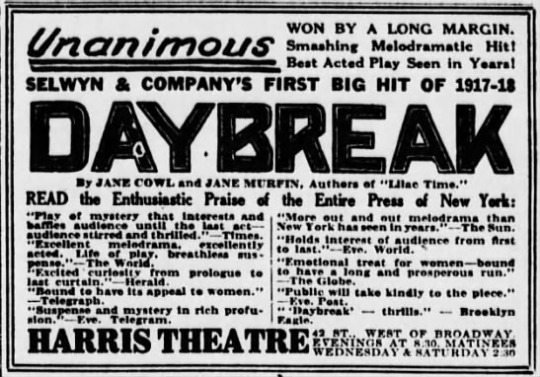
After the play was established on Broadway, Jane Cowl joined the road company of her Lilac Time. As of October 1917, Cowl was also seen on cinema screens in The Spreading Dawn (a title oddly similar to Daybreak), a civil war drama.
Daybreak closed on Broadway on October 13, 1917 after 71 performances.

Daybreak was filmed in 1918 starring Emily Stevens and Julian L’Estrange. It is now considered a lost film.
#Daybreak#Jane Cowl#1917#Jane Murfin#Selwyn & Co#Nixon's Apollo Theatre#Broadway#Broadway Play#Harris Theatre
18 notes
·
View notes
Text
THE ACQUITTAL
1919

The Acquittal is a play in three acts by Rita Weiman. The original production was produced by George M. Cohan and Sam Harris, staged by Sam Forrest.
The cast featured William Harrigan, son of the late entertainer Ned Harrigan. Young Harrigan was recently returned from military service overseas.
Kenneth Winthrop is tried for the murder of his foster-father, Andrew Prentice. His foster-brother, Robert Armstrong is his accuser. Both love Madeline, who has chosen Winthrop. Armstrong alleges that Edith Craig, secretly engaged to the dead man, and Winthrop were in love, but it is not believed. Circumstantial evidence is introduced offering the time as given by a certain clock. Madeline discovers that what they took for a clock in a butcher's store window was a circular meat scale, the hand of which stays at twelve, the top of the scale, when not in use. This discovery clears her husband. A postal inspector produces a letter written on the night of the murder by Prentice, which had been stolen in a mail holdup and recovered. This letter solves the whole mystery and puts the guilt on the shoulders of Prentice, who then confesses and commits suicide. Madeline finally finds happiness with Armstrong, who has always loved her.

The Acquittal premiered in Atlantic City NJ at Nixon’s Apollo Theatre on the Boardwalk on June 30, 1919. It then traveled to Asbury Park and Long Branch.

Instead of moving directly across the river to Broadway, the play decamped to Chicago beginning September 21st. This is likely to await the availability of Cohan and Harris’ flagship theatre on the Rialto. It stayed in the Windy City until December 27, 1919. It made a quick trip to Baltimore before Broadway.

The Acquittal opened on Broadway at the Cohan and Harris Theatre (226 West 42nd Street) on January 5, 1920.
About the Venue: The Cohan and Harris was in 1914 as the Candler, and leased to George M. Cohan and Sam H. Harris until 1920, when they ended their partnership. Harris kept the theatre, renaming it for himself. In 1926, he sold it to the Shuberts, who lost it in a 1933 bankruptcy. It was a movie house from 1933 to 1978 and demolished in 1996. It became part of Madame Tussaud's Wax Museum.
“Do any of you remember that jangly old song titled ‘Harrigan, That's Me'? If you do, you can testify that the gentleman of the piece was more than ordinarily boastful of his ability; that there was very little H A double R I G A N could not do. All of which is a prelude to our statement that ‘The Acquittal,’ Rita Weiman's new drama at the Cohan and Harris Theatre, is made by an unassuming young man of that name. William Harrigan's playing of the square, slangy, likable reporter of The Chronicle, Joe Conway, is one of the best bits of acting we have seen in some time.” ~ McELLIOTT, NY DAILY NEWS
The play closed on May 1, 1920, after 138 performances. After a short break, the play went out on tour again. Harrigan, and Chrystal Herne remained with the cast.
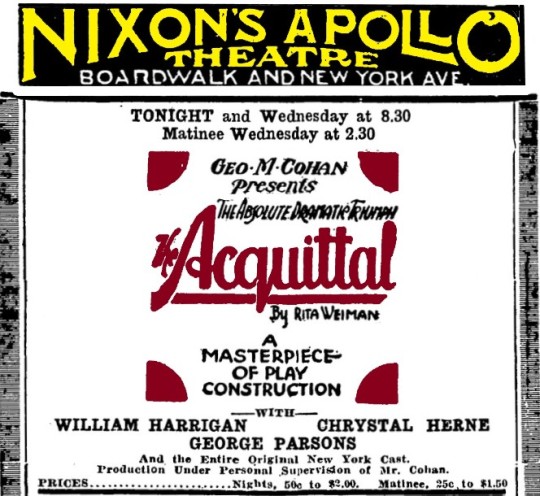
During its post-Broadway tour, the play returned to Atlantic City and Nixon’s Apollo on October 4, 1920.

In 1923, a film version was released by Universal. The film was directed by Clarence Brown starring Norman Kerry, Claire Windsor, Richard Travers, and Barbara Bedford.

The film opened in Atlantic City at the Bijou Theatre on the Boardwalk on November 23, 1923.

In 1953, the play was adapted for television as an installment of “Broadway Television Theatre” on WOR TV, syndicated from New York City. It starred John Baragrey and Judith Evelyn.
#The Acquittal#George M. Cohan#Sam Harris#William Harrigan#Rita Weiman#Drama#Broadway#Broadway Play#Atlantic City#Nixon's Apollo Theatre#Boardwalk
1 note
·
View note
Text
FRIENDLY ENEMIES
1918

Friendly Enemies is a comedy in three acts by Samuel Shipman and Aaron Hoffman. It was originally produced by A.H. Woods starring Sam Bernard and Louis Mann.
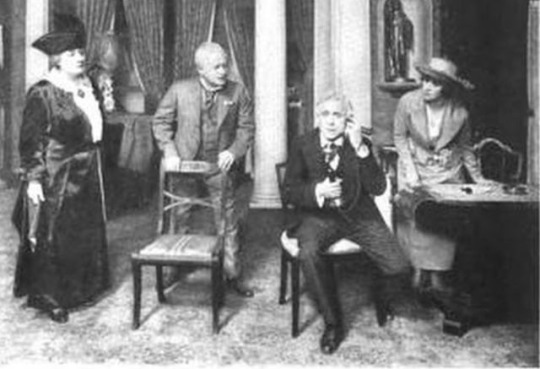
The play was written for Bernard and Mann, although this was their first stage pairing.
Henry Block and Karl Pfeifer are old friends who both immigrated to the United States from Germany. Karl's son Billy and Henry's daughter June are engaged to be married. Henry has assimilated as a patriotic American, including changing his name from Heinrich. Karl refuses to change his name and remains a German patriot. The entry of the United States into World War I against Germany creates conflict between Karl and the others. Karl is secretly giving money to Walter Stuart to fund what Karl thinks is an effort to defuse anti-German propaganda, but Stuart is actually a German agent who uses the money to fund sabotage. Billy enlists in the United States Army against Karl's wishes. When Karl discovers that his money has funded a bomb that sinks the troop transport carrying his son, he changes his position on the war. The play has a happy ending when Billy returns home, having been saved from the sinking ship.
Pfeifer tells Block of a scientist in Germany who discovered a way to make pancakes out of sawdust:
“Ain't that wonderful?"
"Yes, it's wonderful, but who in hell Is going to eat them?"
When war news Is a matter of debate between Pfeifer and Block:
"Paris states..."
"...But Berlin denies.”
“Yes. And no other country has got so much to deny. The truth has not been told in Germany since August 1914."
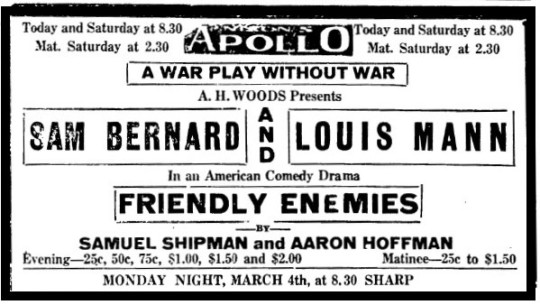
Friendly Enemies premiered in Atlantic City at Nixon’s Apollo Theatre on February 28, 1918. From AC, the play went to DC, where history was made. Due to difficulty in getting the scenery to Washington in time, the play already at the National Theatre, The Land of Joy, extended its run by one day.
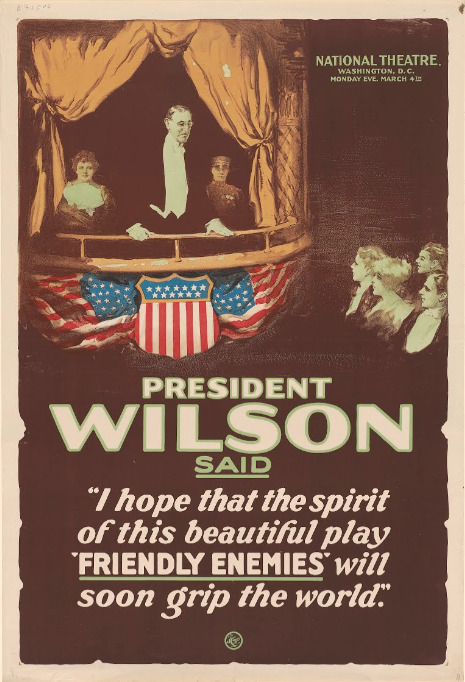
On March 4, 1918, the play made headlines when President Woodrow Wilson attended the production and rose from his box to make a public statement that was widely used in advertising the play.
A year earlier, in his address to Congress to request a declaration of war, Wilson said "We have no quarrel with the German people" and feel "sympathy and friendship" towards them.
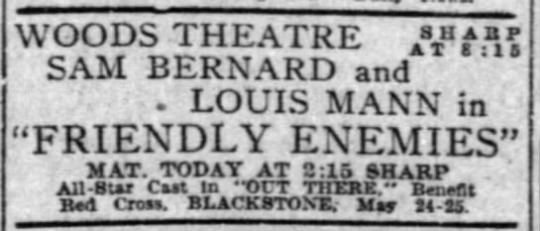
Starting on March 11th, the play inaugurated the new Woods Theatre in Chicago IL. Friendly Enemies was the first play at Woods’ brand new theatre, which had room for 1,312 patrons on two levels.
In 1918, a Mack Sennett comedy film was released titled “Friendly Enemies” but was not related to the play.

The play opened on Broadway at the Hudson Theatre (141 West 44th Street) on July 22, 1918. The play was originally supposed to begin in August, but the date was moved up in order to claim the honor of ‘first play of the new season’, causing the cancelation of several pre-Broadway tryout engagements, including Asbury Park’s Savoy Theatre.
About the Venue: The Hudson was bult in 1903. It was most often used as a TV studio in the 1930s, 40s, and 50s. In 1974, it was a blue movie theatre. In 1980, it became the Savoy, a rock club. In 1987, it received landmark status, so it was incorporated it into the adjacent Millennium Broadway Hotel as a conference center and auditorium. The venue re-opened as a legitimate Broadway theatre in 2017.
"The propaganda is so coated with humor that you've taken it before you can stop and think about it. Every time you begin to feel that it would be rather considerate if they'd turn off the war talk for just a moment, please, and talk about something else, the authors put in a line that gets a laugh, and so the audience has the time of its life." ~ DOROTHY PARKER, VANITY FAIR
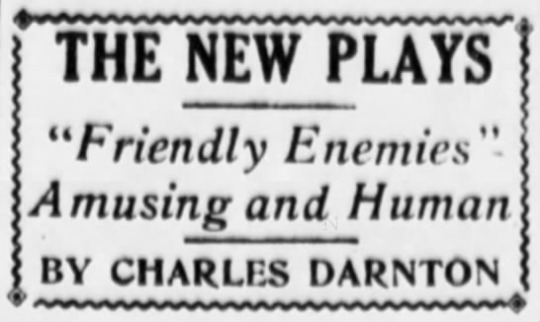
“Pfeifer and Block ae almost as funny as Potash and Perlmutter. In their battle of words those friendly enemies also recall the two old playmates acted by Lew Fields and John Mason In ‘Bosom Friends.'”
It was more than passing warm last night when the new theatrical season opened with the presentation of ‘Friendly Enemies' at the Hudson Theater. But the heat did not let down In the least the delight of the reception it received. It will take a hotter July night next summer to make an audience take less delight in the same play at the same theater. 'Friendly Enemies' can he expected to keep the theatrical home fires burning until another season rolls around. In fact, it ought to last as long as the war itself.” ~ BROOKLYN DAILY EAGLE
Incredibly, the above reviewer was correct on all counts. The play did indeed see another July. It closed on Broadway on July 19, 1919, after 440 performances and 52 weeks at the Hudson. The war ended on November 11, 1918, when the play was still in its fourth month.
During its year on Broadway, four road companies were launched. The Broadway box office earned a record $13,000 a week at the Hudson. Originally cast member Louis Mann was still with the company when it shuttered.
In the UK, the play was re-titled Uncle Sam and was seen in the West End, as well as two regional companies.

The play took the month of August off but intended to resume and launch a tour at the Manhattan Opera House. Coincidentally, August also saw an actors’ strike which briefly delayed the re-opening date.

On November 20, 1919, the play returned to Atlantic City Boardwalk, this time at the Globe Theatre and without Sam Bernard. “The Comedy that encircled the Globe” was playing the Globe.

On November 15, 1920, a stock production of the play opened in Atlantic City at the Woods Theatre (later the Savoy) on the Boardwalk performed by the Vaughn Glaser Players.
The play was adapted to film twice, first in 1925 and then in 1942, with both versions retaining the title Friendly Enemies.

The 1925 adaptation was a black and white silent film directed by George Melford. The film starred the vaudeville team of Lew Fields and Joe Weber, who were colleagues of original play star Sam Bernard.
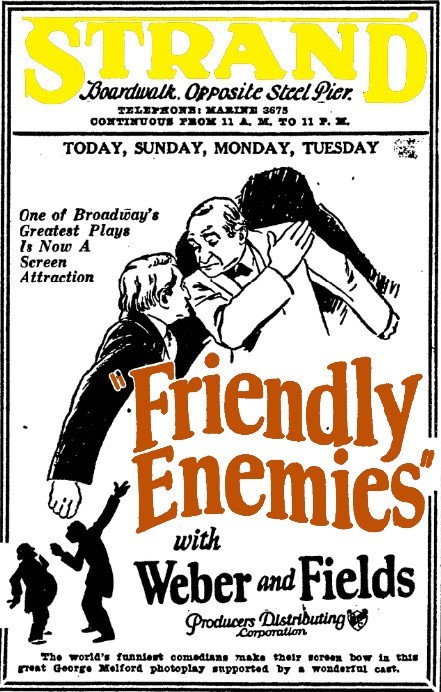
On May 9, 1925, Friendly Enemies was back on the Boardwalk. This time as a film at the Strand Theatre, opposite Steel Pier.

The 1942 adaptation was a black and white sound film directed by Allan Dwan. The film starred vaudevillians Charles Wnninger and Charlie Ruggles.

In late July 1942, Friendly Enemies was back on the Boardwalk. Again, the film (this one with sound) was at the Strand Theatre, opposite Steel Pier.
#Friendly Enemies#Broadway Play#Hudson Theatre#Atlantic City#Boardwalk#Louis Mann#Sam Bernard#Samuel Shipman#Aaron Hoffman#Nixon's Apollo Theatre#Strand Theatre#Globe Theatre#Woods Theatre#A.H. Woods#1918#Woodrow Wilson
3 notes
·
View notes
Text
THE YELLOW TICKET
1914
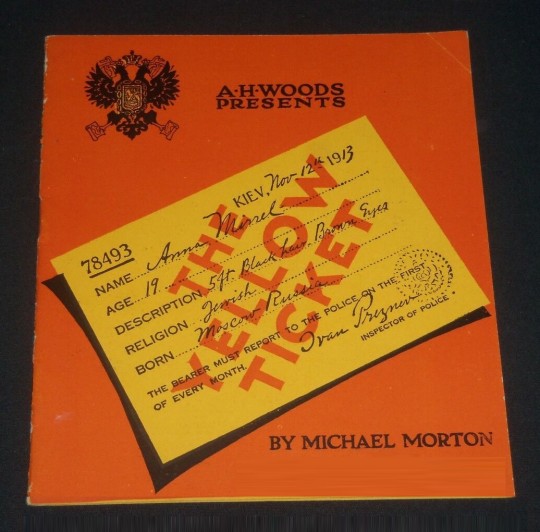
The Yellow Ticket is a play in three acts by Michael Morton. It was originally produced by A.H. Woods starring John Mason as Baron Audrey, and featuring Florence Reed as Sonia and John Barrymore as Julian Rolfe.
Sonia Sokoloff, a young Jewish girl in Czarist St. Petersburg, Russia, is forced to pretend to be a prostitute to obtain a passport (a yellow ticket) in order to visit her father, whom she believes to be ill. When she arrives in St. Petersburg, she learns that her father has been killed. She encounters a young journalist and tells him of the crimes the state perpetrates against its citizens.
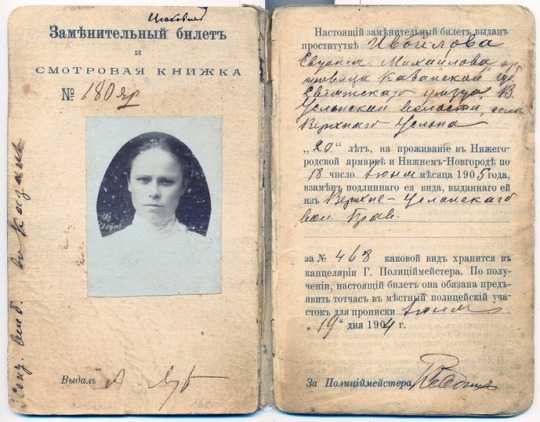
About the Title: A yellow ticket, yellow passport, or yellow card was an informal name for a personal identification document of a prostitute in the Russian Empire. The document combined an ID card, a residence permit, a license to practice prostitution, and prostitute's medical check-up card. In France, criminals were issued yellow ticket upon release, forever branding the person as an ex-con. Jean Valjean’s yellow ticket is a key plot point in Les Miserables.
Rehearsals for the play were partly held at a New York hospital owing to the fact that leading lady Florence Reed suffered appendicitis and had to read her lines in confinement. Playwright Morton, an Englishman, traveled to New York for rehearsals.
Barrymore was not first choice for the role of Julian Rolfe. Several others were cast, but found wanting and released.
The play premiered on New Year’s Day 1914 in New Haven CT. The play was scheduled to open on Broadway on January 6th, but Woods announced a delay the night before, postponing until Friday the 9th. Instead of Broadway, the play performed at the Park Theatre in Bridgeport CT on the evening of the 6th.
On January 9th, it was announced that the Broadway opening would be postponed again, owing to the collapse of Florence Reed, still recuperating from her appendectomy. Woods requested that all opening night tickets be returned to the Eltinge box office for refund. It was then announced that the play would travel to Reading and Allentown PA for tryout performances January 12 through 14.
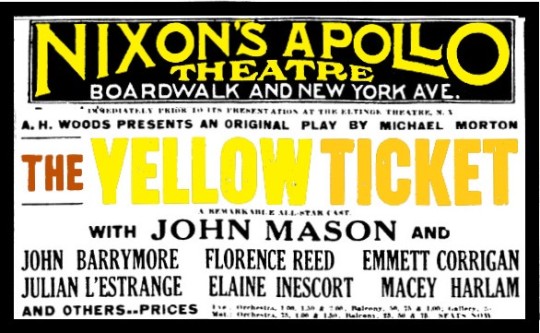
The Yellow Ticket opened in Atlantic City NJ at Nixon’s Apollo Theatre on January 15, 1914. The venue was originally booked to offer The Lost Sister. The last-minute change was attributed to a booking error in their New York office. More than likely, however, that Woods used his considerable influence to find a berth near Broadway for his oft-stalled drama.
Delays due to illness and artistic readiness were not uncommon, but was there something else going on behind the footlights? Perhaps legal tussles were prolonging the delay.

The twice postponed production of Michael Morton's drama, ‘The Yellow Ticket.’ is now scheduled for its New York production by A. H. Woods at the Eltinge Theatre next Tuesday night. In the meantime, Jacob P. Adler, the manager of Adler's Dewey Theatre, last night produced In Yiddish ‘The Yellow Passport,’ a play by Abraham S. Schomer, an East Side attorney, one of the authors of the play now running at the Forty-eighth Street Theatre.
Both plays deal with the same subject, and both Woods and Adler have notified each other through their attorneys that the rival productions must not take place. ‘The Yellow Passport.' however, played to a packed bouse last night at the Dewey Theatre. Last night's performance was not the first for the Schomer drama. It was produced on the East Side three years ago under the title of ‘At Sea,’ and the present production is in the nature of a revival.
Both plays tell the story of a young Russian Jewess who comes into me possession of a yellow ticket issued by the Russian police. This ticket is given to fallen women, and the girl in the play, who has the police passport, although a good woman, is hounded out of every position until an American saves her from final disgrace. Mr. Schomer was on hand to witness the performance of his play at the Dewey last night. He is confident that the new Morton drama was taken from his own play, and is also confident that he will be able to prevent Woods’ production of the piece at the Eltinge Theatre next Tuesday night. Neither A.H. Woods nor Michael Morton could be seen last night, but friends of the manager and author said that the Morton play was an entirely original drama, and that there would be no difficulty in proving that fact. ~ THE NEW YORK TIMES, January 17, 1914

Despite illness, legalities, and endless delays, The Yellow Ticket finally opened on Broadway at Eltinge’s 42nd Street Theatre on January 20, 1914 and enjoyed a run of 183 performances.
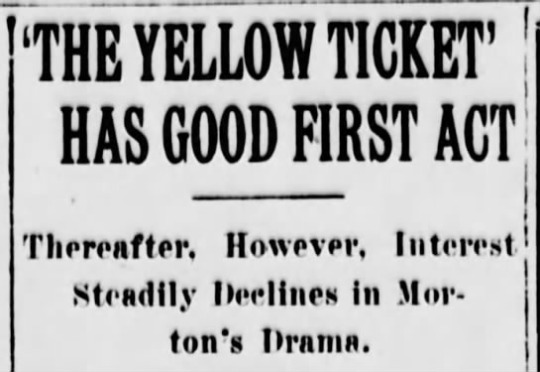
“Michael Morton, author of ‘The Yellow Ticket,’ which was presented at the Eltinge Theater last evening, stated, in a brief speech after the second act, that his primary purpose in writing the play was to expose a condition, or rather, a vicious system that prevails in Russia at the present time, and to arouse public opinion against It. In doing this, Mr. Morton was successful, although be failed to develop a play that did entire credit to bis really big theme, and to his obviously sincere purpose.” ~ BROOKLYN DAILY EAGLE
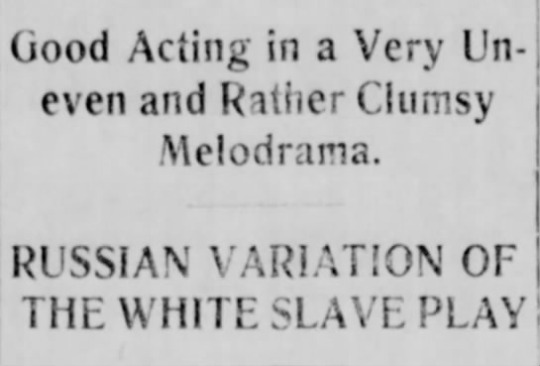


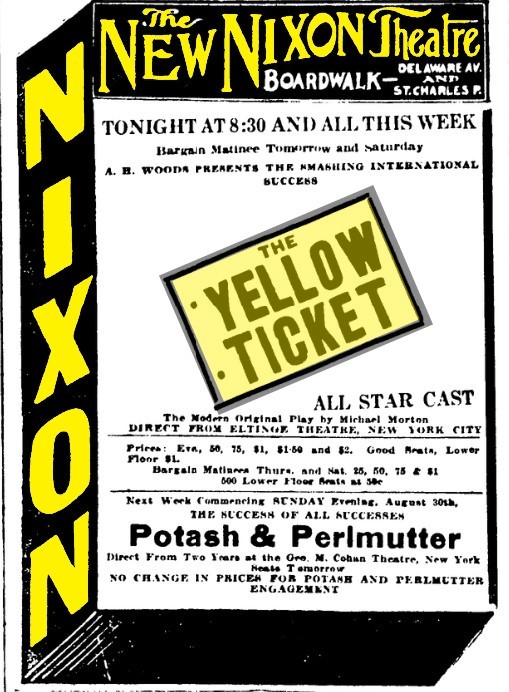
After its Broadway run, the play returned to Atlantic City, this time playing at the New Nixon Theatre, which later became known as the Globe Theatre.

In 1926, John Barrymore returned to the Globe - this time on the silver screen - starring in Don Juan, Warner Brothers’ first sound motion picture.
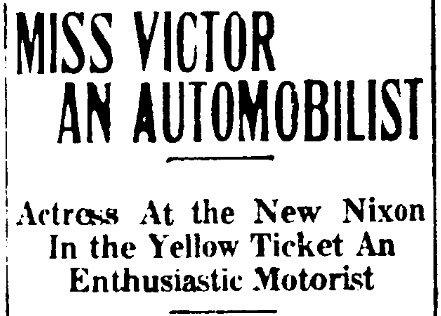
The Atlantic City Press reported that Josephine Victor, leading lady of The Yellow Ticket, was an avid automobilist! The actress enrolled in a course in auto mechanics and went to driving school. She drove herself from New York City to Atlantic City, and intended to drive to Long Branch NJ, the show’s next stop on it’s post Broadway tour.
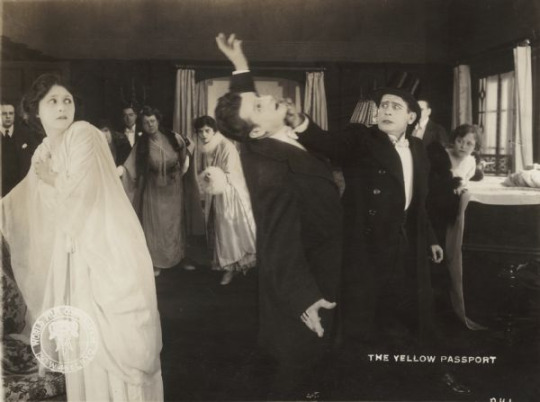
In 1916, the first of three film adaptations of the play appeared. The Yellow Passport was produced and distributed by the World Film Company directed by Edwin August and starring Clara Kimball Young. The film is now considered lost.

The film opened in Atlantic City on February 12, 1916 at the Virginia Theatre. Coincidentally, John Barrymore was simultaneously appearing on screen at Atlantic City’s Colonial Theatre in Nearly A King.
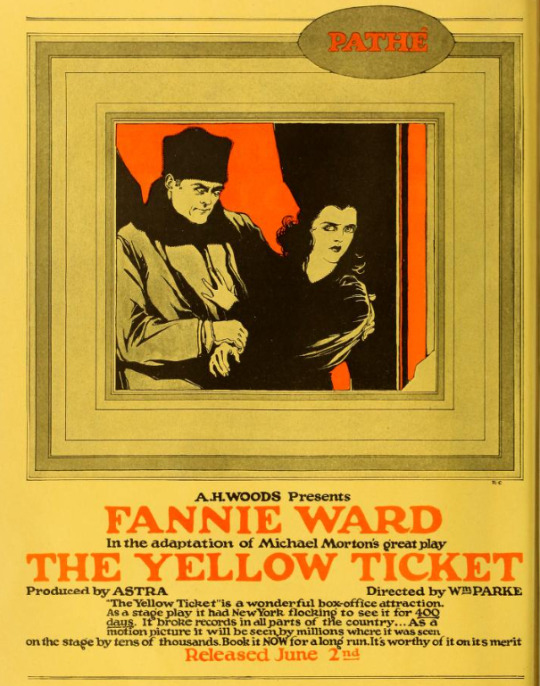
In 1918, the second film adaptation reverted to the play’s original title. It was produced by original stage producer A.H. Woods for Astra Films, distributed by Pathe Exchange starring Fannie Ward. Warner Oland (Charlie Chan) took the role originated by John Mason on stage.

The film opened in Atlantic City on June 1, 1918 at the Cort Theatre for one day only. The Cort had been a legit house operated by A.H. Woods. It was also known as the Savoy Theatre.

The third, and best known film adaptation of the play was released in 1931. It starred Lionel Barrymore, older brother of John Barrymore, in the role of the Baron. Laurence Olivier played the role of Julian, originated by John Barrymore. Boris Karloff appeared uncredited as a drunken orderly.

In Atlantic City, the film was first seen at the Strand Theatre on November 4, 1931, then moving to Atlantic Avenue’s Capitol & Embassy Theatres in December.
#John Barrymore#The Yellow Ticket#The Yellow Passport#Lionel Barrymore#A.H. Woods#Michael Morton#Eltinge Theatre#Nixon's Apollo Theatre#Atlantic City#New Nixon Theatre#Boardwalk#1914#Stage#Broadway Play#Broadway Theatre
5 notes
·
View notes